ZyXEL Communications MAX100 2.5GHz WiMAX PCMCIA card User Manual ZyBook
ZyXEL Communications Corporation 2.5GHz WiMAX PCMCIA card ZyBook
Users Manual

ZyXEL MAX-100 Series
WiMAX PCMCIA Card
User’s Guide
Version 1.00
Edition 1
03/2007

ZyXEL MAX-100 Series User’s Guide
Copyright 3
Copyright
Copyright © 2007 by ZyXEL Communications Corporation.
The contents of this publication may not be reproduced in any part or as a whole, transcribed,
stored in a retrieval system, translated into any language, or transmitted in any form or by any
means, electronic, mechanical, magnetic, optical, chemical, photocopying, manual, or
otherwise, without the prior written permission of ZyXEL Communications Corporation.
Published by ZyXEL Communications Corporation. All rights reserved.
Disclaimer
ZyXEL does not assume any liability arising out of the application or use of any products, or
software described herein. Neither does it convey any license under its patent rights nor the
patent rights of others. ZyXEL further reserves the right to make changes in any products
described herein without notice. This publication is subject to change without notice.
Trademarks
ZyNOS (ZyXEL Network Operating System) is a registered trademark of ZyXEL
Communications, Inc. Other trademarks mentioned in this publication are used for
identification purposes only and may be properties of their respective owners.

ZyXEL MAX-100 Series User’s Guide
4Certifications
Certifications
Federal Communications Commission (FCC) Interference Statement
The device complies with Part 15 of FCC rules. Operation is subject to the following two
conditions:
• This device may not cause harmful interference.
• This device must accept any interference received, including interference that may cause
undesired operations.
This device has been tested and found to comply with the limits for a Class B digital device
pursuant to Part 15 of the FCC Rules. These limits are designed to provide reasonable
protection against harmful interference in a residential installation. This device generates,
uses, and can radiate radio frequency energy, and if not installed and used in accordance with
the instructions, may cause harmful interference to radio communications. However, there is
no guarantee that interference will not occur in a particular installation.
If this device does cause harmful interference to radio/television reception, which can be
determined by turning the device off and on, the user is encouraged to try to correct the
interference by one or more of the following measures:
1Reorient or relocate the receiving antenna.
2Increase the separation between the equipment and the receiver.
3Connect the equipment into an outlet on a circuit different from that to which the receiver
is connected.
4Consult the dealer or an experienced radio/TV technician for help.
FCC Radiation Exposure Statement
• This device has been tested to the FCC exposure requirements (Specific Absorption
Rate).
• Testing was performed on laptop computers with antennas at 0mm spacing. The
maximum SAR value is: 0.850W/kg. The device must not be collocated with any other
antennas or transmitters.
• This equipment has been SAR-evaluated for use in laptops (notebooks) with side slot
configuration.
• The device complies with FCC RF radiation exposure limits set forth for an uncontrolled
environment, under 47 CFR 2.1093 paragraph (d)(2). End users must follow the specific
operating instructions for satisfying RF exposure compliance. To maintain compliance
with FCC RF exposure compliance requirements, please follow operation instruction as
documented in this manual.
• This transmitter must not be co-located or operating in conjunction with any other
antenna or transmitter.

ZyXEL MAX-100 Series User’s Guide
Certifications 5
注意 !
依據 低功率電波輻射性電機管理辦法
第十二條 經型式認證合格之低功率射頻電機,非經許可,公司、商號或使用
者均不得擅自變更頻率、加大功率或變更原設計之特性及功能。
第十四條 低功率射頻電機之使用不得影響飛航安全及干擾合法通信;經發現
有干擾現象時,應立即停用,並改善至無干擾時方得繼續使用。
前項合法通信,指依電信規定作業之無線電信。低功率射頻電機須忍
受合法通信或工業、科學及醫療用電波輻射性電機設備之干擾。
Notices
Changes or modifications not expressly approved by the party responsible for compliance
could void the user's authority to operate the equipment.
This Class B digital apparatus complies with Canadian ICES-003.
Cet appareil numérique de la classe B est conforme à la norme NMB-003 du Canada.
Viewing Certifications
1Go to http://www.zyxel.com.
2Select your product from the drop-down list box on the ZyXEL home page to go to that
product's page.
3Select the certification you wish to view from this page.
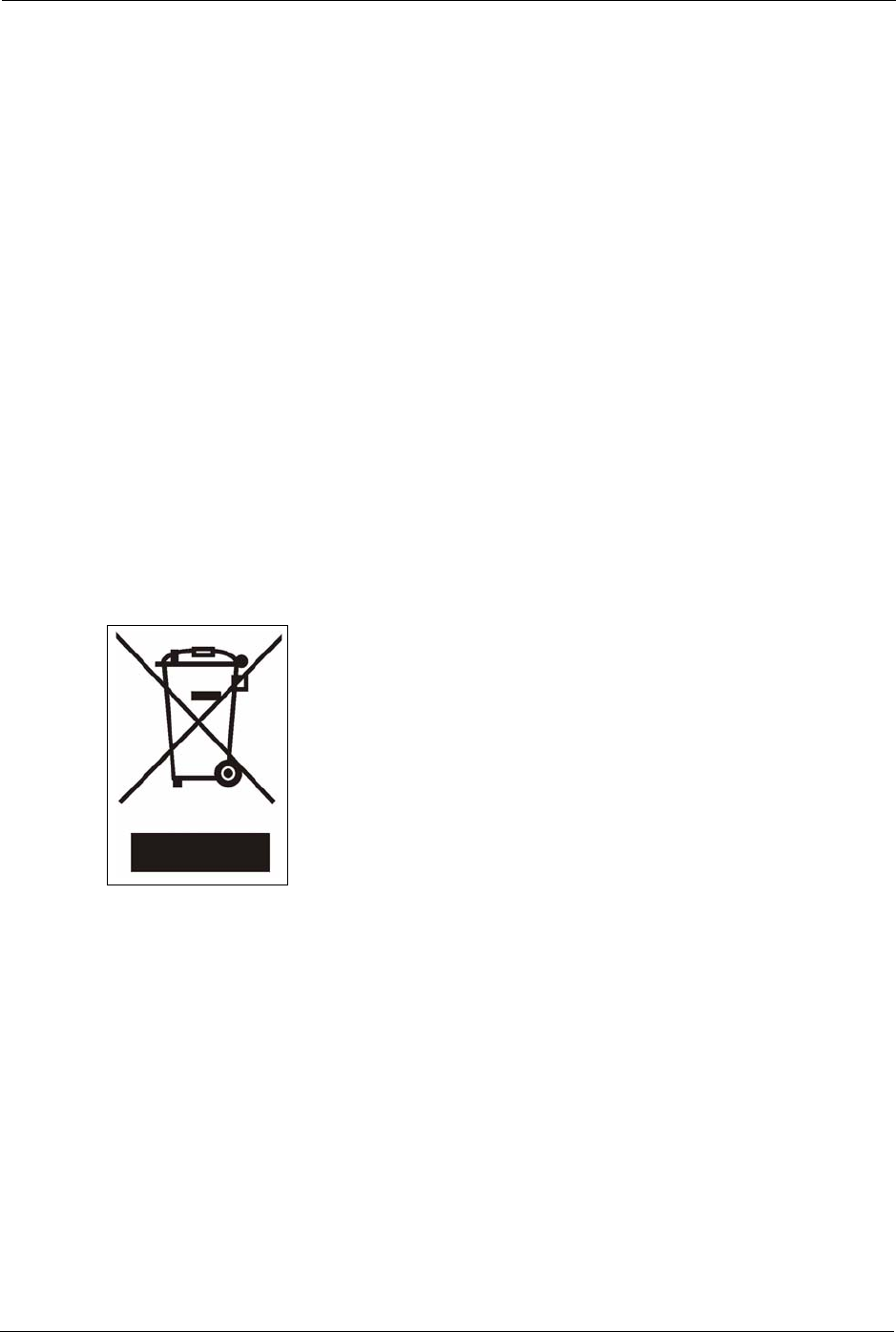
ZyXEL MAX-100 Series User’s Guide
6Safety Warnings
Safety Warnings
For your safety, be sure to read and follow all warning notices and instructions.
• Do NOT use this product near water, for example, in a wet basement or near a swimming
pool.
• Do NOT expose your device to dampness, dust or corrosive liquids.
• Do NOT store things on the device.
• Do NOT install, use, or service this device during a thunderstorm. There is a remote risk
of electric shock from lightning.
• Connect ONLY suitable accessories to the device.
• Do NOT open the device or unit. Opening or removing covers can expose you to
dangerous high voltage points or other risks. ONLY qualified service personnel should
service or disassemble this device. Please contact your vendor for further information.
• Do not use the device outside, and make sure all the connections are indoors. There is a
remote risk of electric shock from lightning.
• Antenna Warning! This device meets ETSI and FCC certification requirements when
using the included antenna(s). Only use the included antenna(s).
This product is recyclable. Dispose of it properly.

ZyXEL MAX-100 Series User’s Guide
ZyXEL Limited Warranty 7
ZyXEL Limited Warranty
ZyXEL warrants to the original end user (purchaser) that this product is free from any defects
in materials or workmanship for a period of up to two years from the date of purchase. During
the warranty period, and upon proof of purchase, should the product have indications of failure
due to faulty workmanship and/or materials, ZyXEL will, at its discretion, repair or replace the
defective products or components without charge for either parts or labor, and to whatever
extent it shall deem necessary to restore the product or components to proper operating
condition. Any replacement will consist of a new or re-manufactured functionally equivalent
product of equal or higher value, and will be solely at the discretion of ZyXEL. This warranty
shall not apply if the product has been modified, misused, tampered with, damaged by an act
of God, or subjected to abnormal working conditions.
Note
Repair or replacement, as provided under this warranty, is the exclusive remedy of the
purchaser. This warranty is in lieu of all other warranties, express or implied, including any
implied warranty of merchantability or fitness for a particular use or purpose. ZyXEL shall in
no event be held liable for indirect or consequential damages of any kind to the purchaser.
To obtain the services of this warranty, contact ZyXEL's Service Center for your Return
Material Authorization number (RMA). Products must be returned Postage Prepaid. It is
recommended that the unit be insured when shipped. Any returned products without proof of
purchase or those with an out-dated warranty will be repaired or replaced (at the discretion of
ZyXEL) and the customer will be billed for parts and labor. All repaired or replaced products
will be shipped by ZyXEL to the corresponding return address, Postage Paid. This warranty
gives you specific legal rights, and you may also have other rights that vary from country to
country.
Registration
Register your product online to receive e-mail notices of firmware upgrades and information
at www.zyxel.com for global products, or at www.us.zyxel.com for North American products.

ZyXEL MAX-100 Series User’s Guide
8Customer Support
Customer Support
Please have the following information ready when you contact customer support.
• Product model and serial number.
• Warranty Information.
• Date that you received your device.
• Brief description of the problem and the steps you took to solve it.
METHOD
LOCATION
SUPPORT E-MAIL TELEPHONE WEB SITE
REGULAR MAIL
SALES E-MAIL FAX FTP SITE
CORPORATE
HEADQUARTERS
(WORLDWIDE)
support@zyxel.com.tw +886-3-578-3942 www.zyxel.com
www.europe.zyxel.com
ZyXEL Communications Corp.
6 Innovation Road II
Science Park
Hsinchu 300
Ta i w a n
sales@zyxel.com.tw +886-3-578-2439 ftp.zyxel.com
ftp.europe.zyxel.com
COSTA RICA
soporte@zyxel.co.cr +506-2017878 www.zyxel.co.cr ZyXEL Costa Rica
Plaza Roble Escazú
Etapa El Patio, Tercer Piso
San José, Costa Rica
sales@zyxel.co.cr +506-2015098 ftp.zyxel.co.cr
CZECH REPUBLIC
info@cz.zyxel.com +420-241-091-350 www.zyxel.cz ZyXEL Communications
Czech s.r.o.
Modranská 621
143 01 Praha 4 - Modrany
Ceská Republika
info@cz.zyxel.com +420-241-091-359
DENMARK
support@zyxel.dk +45-39-55-07-00 www.zyxel.dk ZyXEL Communications A/S
Columbusvej
2860 Soeborg
Denmark
sales@zyxel.dk +45-39-55-07-07
FINLAND
support@zyxel.fi +358-9-4780-8411 www.zyxel.fi ZyXEL Communications Oy
Malminkaari 10
00700 Helsinki
Finland
sales@zyxel.fi +358-9-4780 8448
FRANCE
info@zyxel.fr +33-4-72-52-97-97 www.zyxel.fr ZyXEL France
1 rue des Vergers
Bat. 1 / C
69760 Limonest
France
+33-4-72-52-19-20
GERMANY
support@zyxel.de +49-2405-6909-69 www.zyxel.de ZyXEL Deutschland GmbH.
Adenauerstr. 20/A2 D-52146
Wuerselen
Germany
sales@zyxel.de +49-2405-6909-99
HUNGARY
support@zyxel.hu +36-1-3361649 www.zyxel.hu ZyXEL Hungary
48, Zoldlomb Str.
H-1025, Budapest
Hungary
info@zyxel.hu +36-1-3259100
KAZAKHSTAN
http://zyxel.kz/support +7-3272-590-698 www.zyxel.kz ZyXEL Kazakhstan
43, Dostyk ave.,Office 414
Dostyk Business Centre
050010, Almaty
Republic of Kazakhstan
sales@zyxel.kz +7-3272-590-689
NORTH AMERICA
support@zyxel.com 1-800-255-4101
+1-714-632-0882
www.us.zyxel.com ZyXEL Communications Inc.
1130 N. Miller St.
Anaheim
CA 92806-2001
U.S.A.
sales@zyxel.com +1-714-632-0858 ftp.us.zyxel.com

ZyXEL MAX-100 Series User’s Guide
Customer Support 9
“+” is the (prefix) number you enter to make an international telephone call.
NORWAY
support@zyxel.no +47-22-80-61-80 www.zyxel.no ZyXEL Communications A/S
Nils Hansens vei 13
0667 Oslo
Norway
sales@zyxel.no +47-22-80-61-81
POLAND
info@pl.zyxel.com +48 (22) 333 8250 www.pl.zyxel.com ZyXEL Communications
ul. Okrzei 1A
03-715 Warszawa
Poland
+48 (22) 333 8251
RUSSIA
http://zyxel.ru/support +7-095-542-89-29 www.zyxel.ru ZyXEL Russia
Ostrovityanova 37a Str.
Moscow, 117279
Russia
sales@zyxel.ru +7-095-542-89-25
SPAIN
support@zyxel.es +34-902-195-420 www.zyxel.es ZyXEL Communications
Arte, 21 5ª planta
28033 Madrid
Spain
sales@zyxel.es +34-913-005-345
SWEDEN
support@zyxel.se +46-31-744-7700 www.zyxel.se ZyXEL Communications A/S
Sjöporten 4, 41764 Göteborg
Sweden
sales@zyxel.se +46-31-744-7701
UKRAINE
support@ua.zyxel.com +380-44-247-69-78 www.ua.zyxel.com ZyXEL Ukraine
13, Pimonenko Str.
Kiev, 04050
Ukraine
sales@ua.zyxel.com +380-44-494-49-32
UNITED KINGDOM
support@zyxel.co.uk +44-1344 303044
08707 555779 (UK only)
www.zyxel.co.uk ZyXEL Communications UK
Ltd.,11 The Courtyard,
Eastern Road, Bracknell,
Berkshire, RG12 2XB,
United Kingdom (UK)
sales@zyxel.co.uk +44-1344 303034 ftp.zyxel.co.uk
METHOD
LOCATION
SUPPORT E-MAIL TELEPHONE WEB SITE
REGULAR MAIL
SALES E-MAIL FAX FTP SITE

ZyXEL MAX-100 Series User’s Guide
10 Customer Support

ZyXEL MAX-100 Series User’s Guide
Table of Contents 11
Table of Contents
Copyright .................................................................................................................. 3
Certifications ............................................................................................................ 4
Safety Warnings ....................................................................................................... 6
ZyXEL Limited Warranty.......................................................................................... 7
Customer Support.................................................................................................... 8
Table of Contents ................................................................................................... 11
List of Tables .......................................................................................................... 13
List of Figures ........................................................................................................ 15
Preface .................................................................................................................... 17
Chapter 1
Getting Started ....................................................................................................... 19
1.1 About Your ZyXEL Device ................................................................................19
1.2 Application Overview ..........................................................................................19
1.3 ZyXEL Device Hardware ....................................................................................20
1.4 The ZyXEL Utility ...............................................................................................20
1.4.1 Accessing the ZyXEL Utility .....................................................................21
Chapter 2
Tutorial .................................................................................................................... 23
2.1 Connecting to the Internet ..................................................................................23
2.1.1 Set Up Your User Name and Password ...................................................23
2.1.2 Set Up Search Frequencies ......................................................................24
2.1.3 Confirm the Connection ............................................................................25
Chapter 3
Wireless Configuration.......................................................................................... 27
3.1 WiMAX Overview ...............................................................................................27
3.2 ZyXEL Utility Summary .....................................................................................28
3.3 The Link Info Screen ..........................................................................................29
3.4 Frequency Settings ............................................................................................31
3.4.1 Frequency Ranges ...................................................................................31
3.5 The Site Survey Screen .....................................................................................32

ZyXEL MAX-100 Series User’s Guide
12 Table of Contents
3.5.1 Site Survey: Manual ..................................................................................33
3.5.2 Site Survey: Express ................................................................................34
3.5.2.1 Using the Site Survey Screen (Express): Example .........................35
3.6 Authentication ....................................................................................................37
3.7 The Profile Screen .............................................................................................38
3.8 The Adapter Screen ...........................................................................................39
3.8.1 Uploading Firmware ..................................................................................40
Chapter 4
Maintenance ........................................................................................................... 43
4.1 The About Screen .............................................................................................43
4.2 Uninstalling the ZyXEL Utility ............................................................................43
4.3 Upgrading the ZyXEL Utility ..............................................................................44
Chapter 5
Troubleshooting ..................................................................................................... 47
5.1 Problems Starting the ZyXEL Utility ...................................................................47
5.2 Problems Connecting to the Internet ..................................................................47
5.3 Problems with the Link Quality ...........................................................................48
Appendix A
Product Specifications .......................................................................................... 49
Appendix B
WiMAX Security...................................................................................................... 51
Appendix C
Setting up Your Computer’s IP Address.............................................................. 55
Index........................................................................................................................ 61

ZyXEL MAX-100 Series User’s Guide
List of Tables 13
List of Tables
Table 1 Models Covered ....................................................................................... 19
Table 2 The ZyXEL Device .................................................................................... 20
Table 3 ZyXEL Utility: System Tray Icon ............................................................... 21
Table 4 Tutorial: Example Account Information ..................................................... 23
Table 5 ZyXEL Utility Summary ............................................................................. 29
Table 6 The Link Info Screen ................................................................................ 30
Table 7 Radio Frequency Conversion ................................................................... 31
Table 8 DL Frequency Example Settings .............................................................. 33
Table 9 The Site Survey Screen (Manual) ............................................................ 34
Table 10 The Site Survey Screen (Express) ......................................................... 35
Table 11 Example Supported Frequencies (GHz) ................................................. 35
Table 12 Example Frequency Settings .................................................................. 35
Table 13 The Profile Screen .................................................................................. 38
Table 14 The Adapter Screen ............................................................................... 40
Table 15 About ...................................................................................................... 43
Table 16 Troubleshooting Starting the ZyXEL Utility ............................................. 47
Table 17 Troubleshooting Internet Connection ...................................................... 47
Table 18 Troubleshooting Link Quality .................................................................. 48
Table 19 Product Specifications ............................................................................ 49

ZyXEL MAX-100 Series User’s Guide
14 List of Tables

ZyXEL MAX-100 Series User’s Guide
List of Figures 15
List of Figures
Figure 1 Mobile Station and Base Station .............................................................. 19
Figure 2 The ZyXEL Device ................................................................................... 20
Figure 3 ZyXEL Utility: System Tray Icon .............................................................. 21
Figure 4 Tutorial: Profile Screen ............................................................................. 24
Figure 5 Tutorial: Site Survey Screen (Manual) ..................................................... 24
Figure 6 Tutorial: Completing the Manual Site Survey Screen .............................. 25
Figure 7 Tutorial: Link Info Screen ......................................................................... 25
Figure 8 WiMax: Mobile Station ............................................................................. 27
Figure 9 WiMAX: Multiple Mobile Stations ............................................................. 28
Figure 10 ZyXEL Utility Summary ......................................................................... 28
Figure 11 The Link Info Screen .............................................................................. 29
Figure 12 Frequency Ranges ................................................................................. 32
Figure 13 The Site Survey Screen (manual) .......................................................... 34
Figure 14 The Site Survey Screen (Express) ......................................................... 34
Figure 15 Search Example 1 .................................................................................. 36
Figure 16 Search Example 2 .................................................................................. 36
Figure 17 Frequency Values .................................................................................. 36
Figure 18 Automatic Completion ............................................................................ 37
Figure 19 Authentication ........................................................................................ 37
Figure 20 The Profile Screen ................................................................................ 38
Figure 21 The Adapter Screen ............................................................................... 39
Figure 22 Adapter: Upload Firmware ..................................................................... 40
Figure 23 About ..................................................................................................... 43
Figure 24 Uninstall: Confirm ................................................................................. 44
Figure 25 Uninstall: Finish ..................................................................................... 44
Figure 26 Windows XP: Start Menu ....................................................................... 55
Figure 27 Windows XP: Control Panel ................................................................... 56
Figure 28 Windows XP: Control Panel: Network Connections: Properties ............ 56
Figure 29 Windows XP: Local Area Connection Properties ................................... 57
Figure 30 Windows XP: Internet Protocol TCP/IP Properties ................................ 57
Figure 31 Windows XP: Advanced TCP/IP Settings .............................................. 58
Figure 32 Windows XP: Internet Protocol (TCP/IP) Properties .............................. 59

ZyXEL MAX-100 Series User’s Guide
16 List of Figures

ZyXEL MAX-100 Series User’s Guide
Preface 17
Preface
Congratulations on your purchase of the ZyXEL MAX-100 Series WiMAX PCMCIA Card.
Your ZyXEL Device plugs into a PCMCIA port on your notebook computer and allows you to
access WiMAX wireless networks.
Your ZyXEL Device is easy to install and configure.
About This User's Guide
This manual is designed to guide you through the configuration of your ZyXEL Device for its
various applications.
Related Documentation
• Supporting Disk
Refer to the included CD for support documents.
• Quick Start Guide
The Quick Start Guide is designed to help you get up and running right away. It contains
hardware installation/connection information.
• ZyXEL Web Site
Please go to http://www.zyxel.com for product news, firmware, updated documents, and
other support materials.
User Guide Feedback
Help us help you. E-mail all User’s Guide-related comments, questions or suggestions for
improvement to techwriters@zyxel.com.tw or send regular mail to The Technical Writing
Team, ZyXEL Communications Corp., 6 Innovation Road II, Science-Based Industrial Park,
Hsinchu, 300, Taiwan. Thank you.
Syntax Conventions
• “Enter” means for you to type one or more characters. “Select” or “Choose” means for
you to use one predefined choice.
• Mouse action sequences are denoted using a right angle bracket ( > ). For example, “In
Windows, click Start > Settings > Control Panel” means first click the Start button,
then point your mouse pointer to Settings and then click Control Panel.
• “e.g.,” is a shorthand for “for instance”, and “i.e.,” means “that is” or “in other words”.
• The ZyXEL MAX-100 Series WiMAX PCMCIA Card may be referred to as “the ZyXEL
Device” or “the device” in this user’s guide.
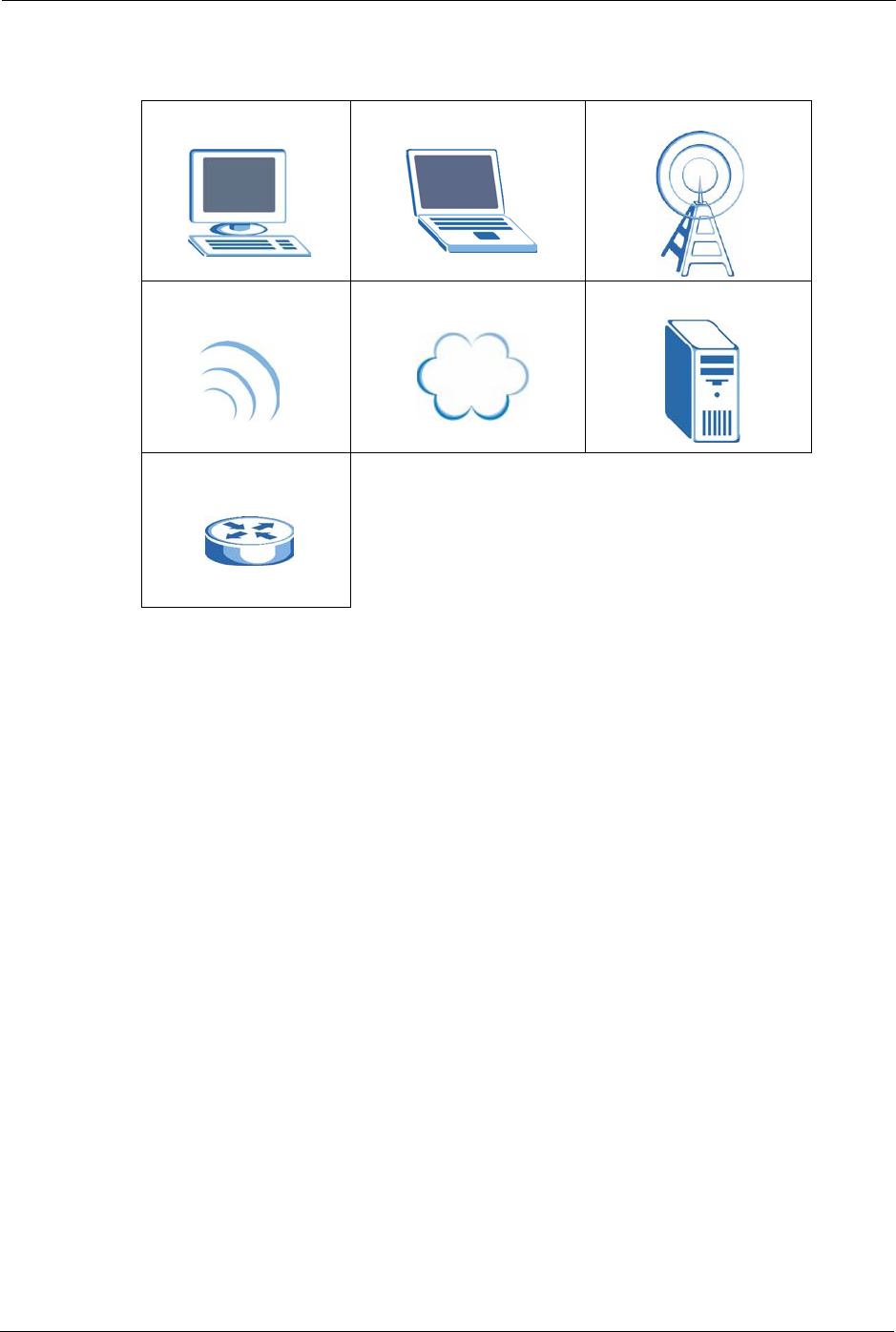
ZyXEL MAX-100 Series User’s Guide
18 Preface
Graphics Icons Key
Computer Notebook Computer Wireless Base Station
Wireless Signal Internet Cloud Server
Router
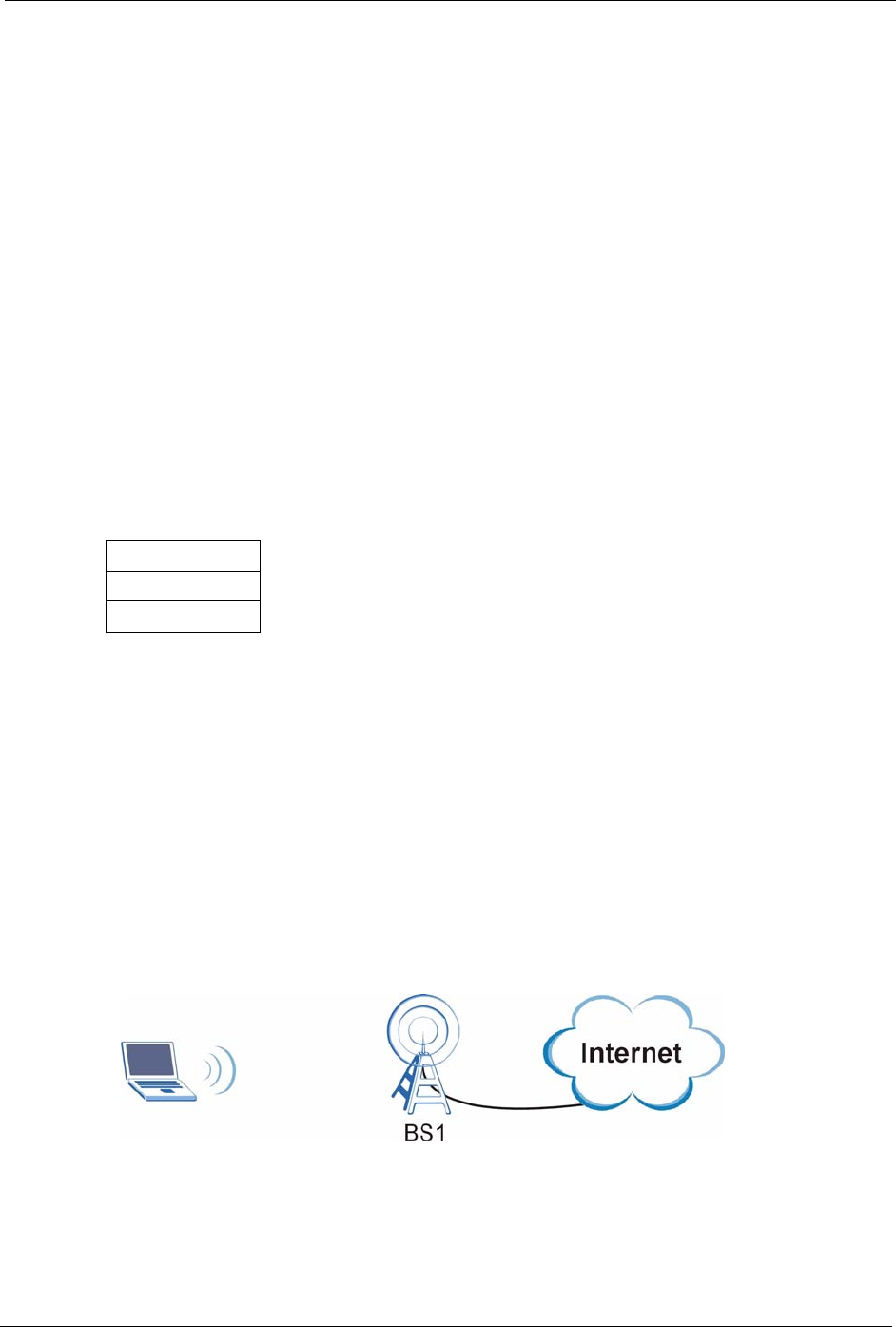
ZyXEL MAX-100 Series User’s Guide
Chapter 1 Getting Started 19
CHAPTER 1
Getting Started
This chapter introduces the ZyXEL Device and prepares you to use the ZyXEL utility. The
ZyXEL utility is a tool that helps you configure your ZyXEL Device.
1.1 About Your ZyXEL Device
The ZyXEL Device is an IEEE 802.16e compliant WiMAX wireless card for your notebook
computer. See the appendix for detailed product specifications.
At the time of writing this User’s Guide covers the following models:
This User’s Guide uses screens and example settings from the MAX-100 model.
1.2 Application Overview
In a wireless metropolitan area network (MAN), the ZyXEL Device connects to a base station
(BS) for Internet access.
The following diagram shows a notebook computer equipped with the ZyXEL Device
connecting to the Internet through a base station BS1.
Figure 1 Mobile Station and Base Station
Table 1 Models Covered
MAX-100
MAX-110
MAX-130
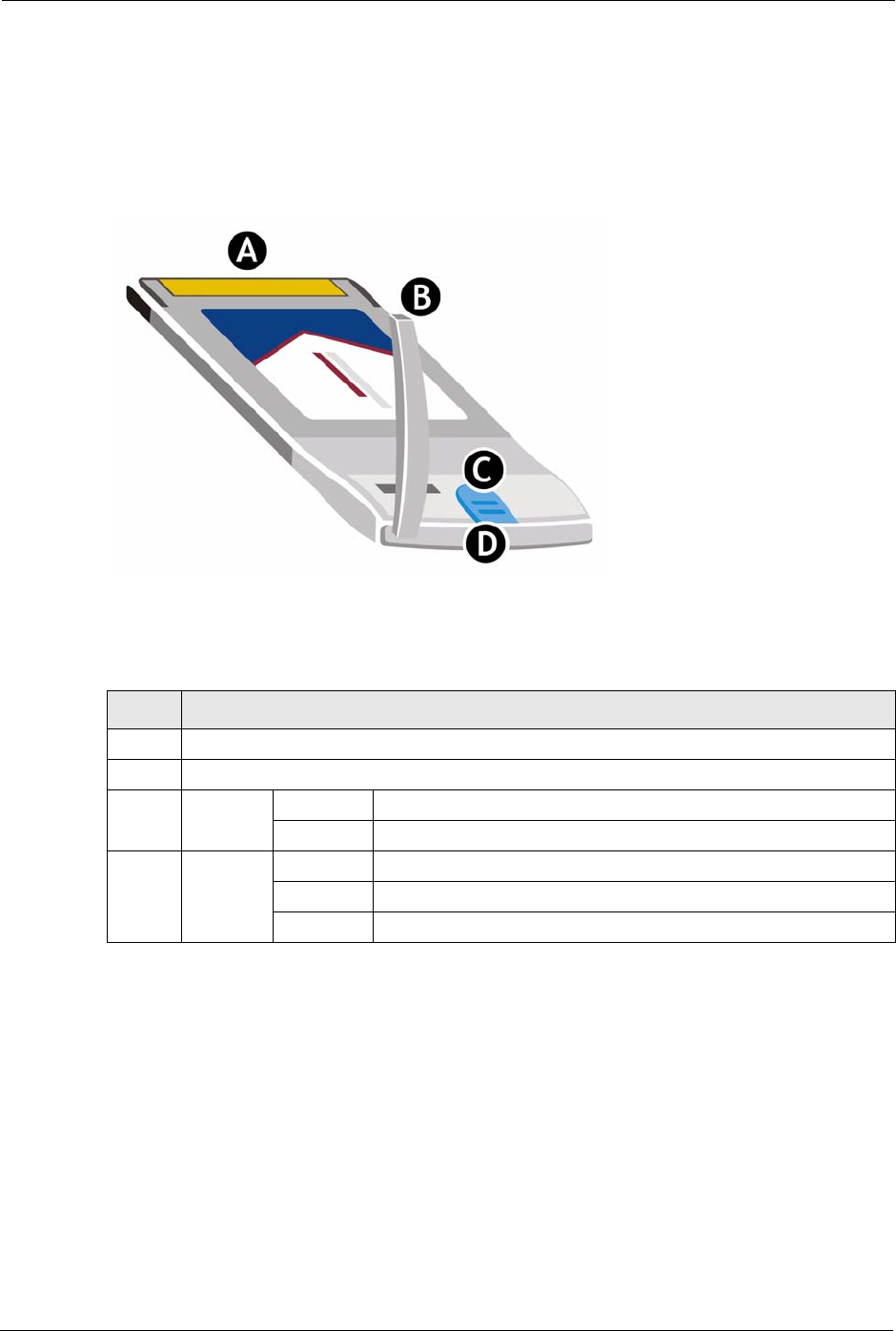
ZyXEL MAX-100 Series User’s Guide
20 Chapter 1 Getting Started
1.3 ZyXEL Device Hardware
Follow the instructions in the Quick Start Guide to install the ZyXEL utility and make
hardware connections.
Figure 2 The ZyXEL Device
The following table describes the ZyXEL Device.
1.4 The ZyXEL Utility
After you install the ZyXEL utility and insert the ZyXEL Device, an icon appears in the
system tray.
Note: The ZyXEL utility system tray icon displays only when the ZyXEL Device is
inserted properly.
Table 2 The ZyXEL Device
LABEL DESCRIPTION
A PCMCIA connector.
B 2dBi rotating antenna
C PWR LED ON The ZyXEL Device is properly connected and receiving power.
OFF The ZyXEL Device is not receiving power.
D LINK LED ON The ZyXEL Device has a connection with a base station.
BLINKING The ZyXEL Device is connecting with a base station.
OFF The ZyXEL Device does not have a connection with a base station.

ZyXEL MAX-100 Series User’s Guide
Chapter 1 Getting Started 21
Figure 3 ZyXEL Utility: System Tray Icon
The color of the ZyXEL utility system tray icon indicates whether the ZyXEL Device is
connected to a wireless network. Refer to the following table for details.
1.4.1 Accessing the ZyXEL Utility
Double-click on the ZyXEL utility icon in the system tray to open the ZyXEL utility.
The ZyXEL utility screens are similar in all Microsoft Windows versions.
Table 3 ZyXEL Utility: System Tray Icon
COLOR DESCRIPTION
Orange The ZyXEL Device is not connected to a wireless network, or is starting up.
Green The ZyXEL Device is connected to a wireless network.
Blue The ZyXEL Device is connected to a wireless network, but is in power saving mode or
changing its connection from one base station to another.
See Section 3.3 on page 29 for information on WiMAX states.

ZyXEL MAX-100 Series User’s Guide
22 Chapter 1 Getting Started

ZyXEL MAX-100 Series User’s Guide
Chapter 2 Tutorial 23
CHAPTER 2
Tutorial
The following example shows you how to configure settings to join a wireless network and
access the Internet using the ZyXEL utility.
2.1 Connecting to the Internet
There are three parts to this example, as follows:
1Set up your user name and password (in the Profile screen).
2Set up search frequencies (in the Site Survey screen).
3Confirm the connection (in the Link Info screen).
To access the Internet, you need information from your Internet Service Provider (ISP) about
your account and the network. In this example, your ISP has given you the following
information about your account:
See Section 3.4 on page 31 for more information on radio frequencies.
2.1.1 Set Up Your User Name and Password
After you install the ZyXEL utility and then insert the ZyXEL Device (see the Quick Start
Guide for details) follow the steps below to set up your user name and password.
1Start the ZyXEL utility and click the Profile tab to open the screen shown next.
Table 4 Tutorial: Example Account Information
User name User1234
Password xyz9876
Anonymous Identity anonymous@zyxel.com
Available Frequencies 2.5, 2.525, 2.6 and 2.625
gigahertz (GHz)
Downlink Frequency
Step
25 megahertz (MHz)
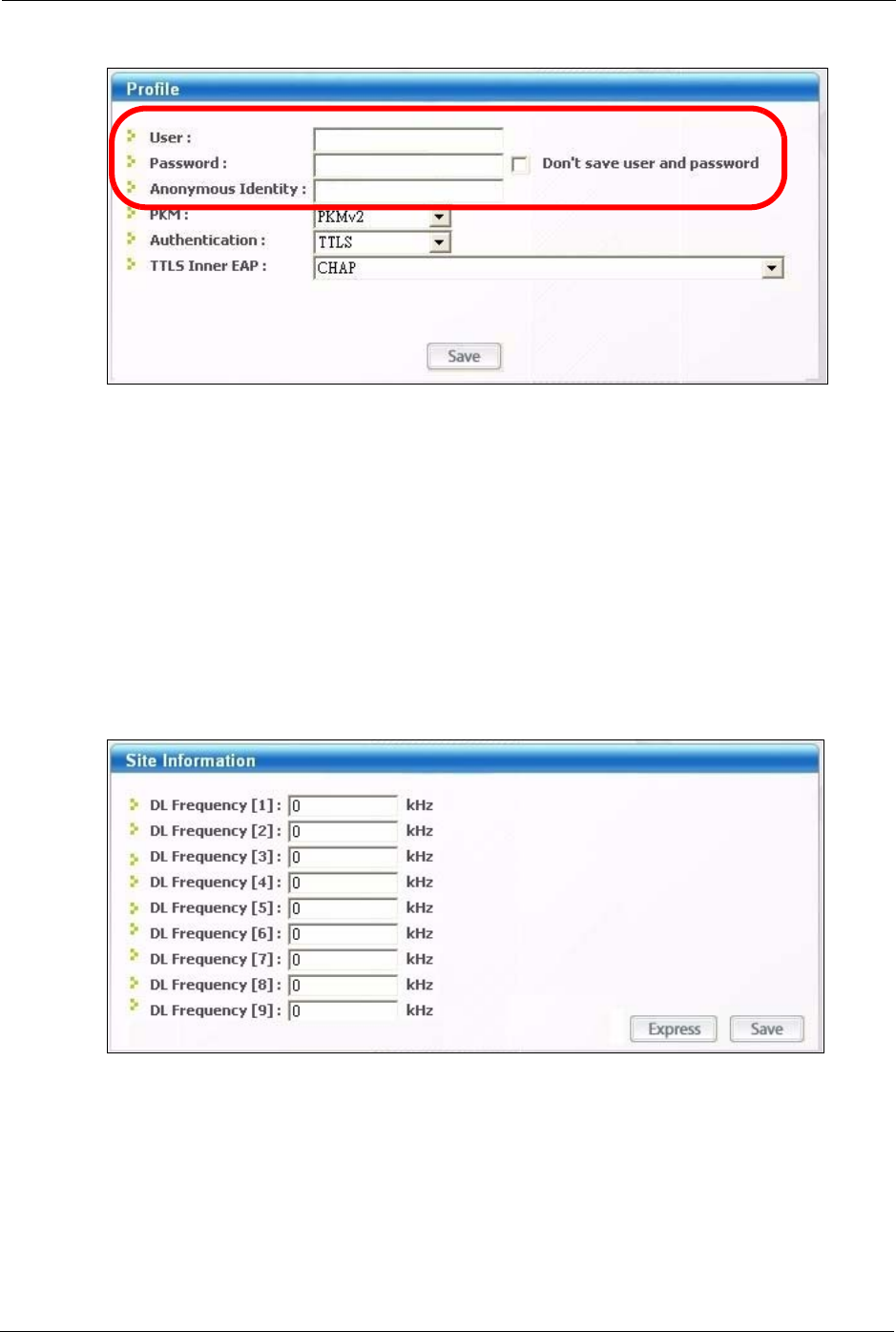
ZyXEL MAX-100 Series User’s Guide
24 Chapter 2 Tutorial
Figure 4 Tutorial: Profile Screen
2In the User field, enter your user name (“User1234”) and in the Password field, enter
your password (“xyz9876”). Select the Don’t save user and password box if you don’t
want anyone who uses the ZyXEL Device on this computer to be able to access the
Internet using your account details. Enter your Anonymous Identity
(“anonymous@zyxel.com”) and leave the other fields at their default values. Click the
Save button.
2.1.2 Set Up Search Frequencies
1Click the Site Survey tab to open the screen shown next. The Site Survey screen allows
you to specify a set of frequencies to search for a connection to a base station. The
Manual site survey screen displays.
Figure 5 Tutorial: Site Survey Screen (Manual)
2You have chosen to use the Manual site survey screen because you need to enter four
different frequencies. See Section 3.5 on page 32 for more information on when to use the
Manual or the Express site survey screen.
•In the DL Frequency [1] field, enter 2500000 (2500000 kilohertz (kHz) is equal
to 2.5 gigahertz).
•In the DL Frequency [2] field, enter 2525000.
•In the DL Frequency [3] field, enter 2600000.
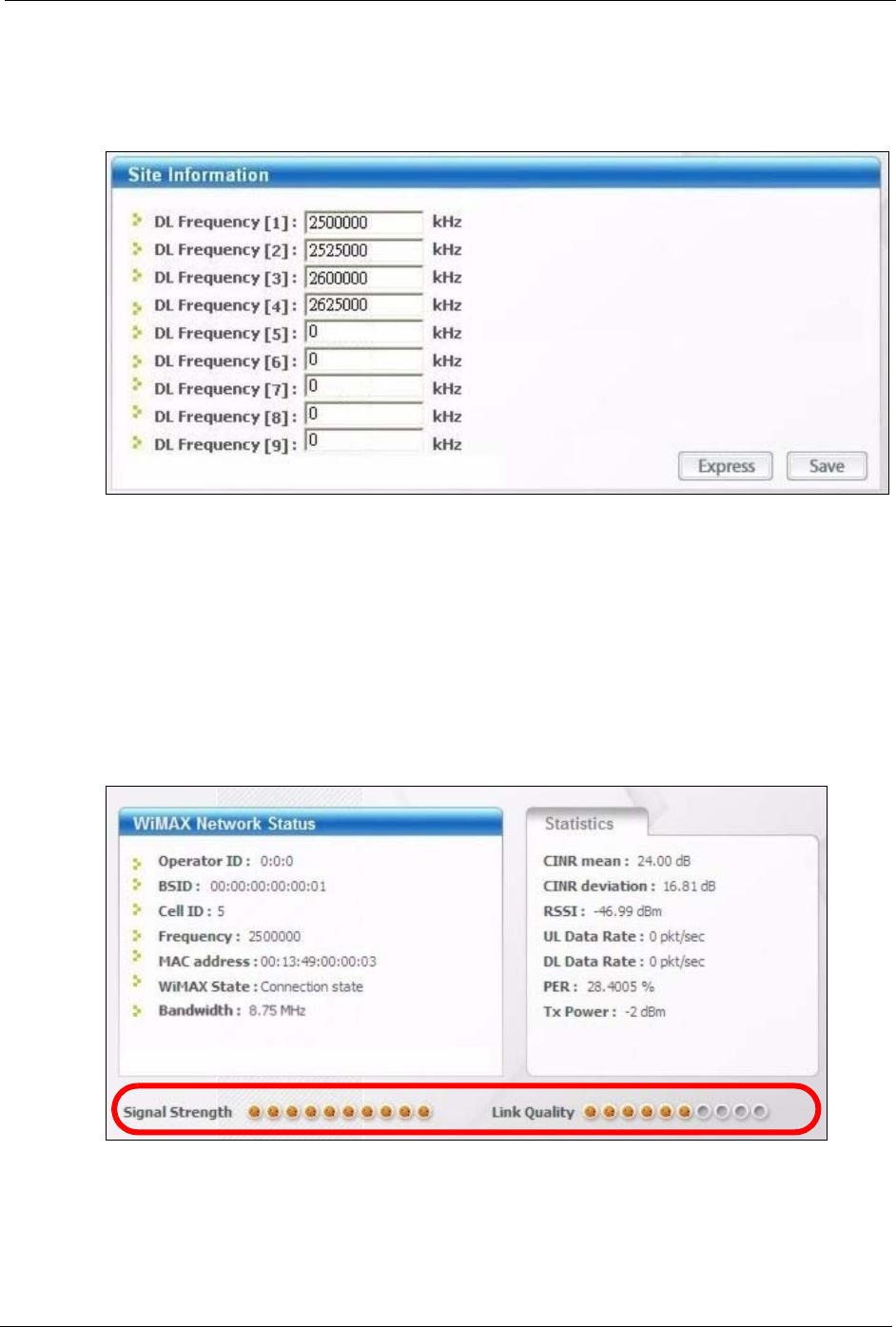
ZyXEL MAX-100 Series User’s Guide
Chapter 2 Tutorial 25
•In the DL Frequency [4] field, enter 2625000.
Leave the rest of the DL Frequency fields at zero.
Figure 6 Tutorial: Completing the Manual Site Survey Screen
3Click Save. The ZyXEL Device stores your settings.
4When the ZyXEL Device searches for available frequencies, it scans all frequencies from
DL Frequency [1] to DL Frequency [4].
2.1.3 Confirm the Connection
1Click the Link Info tab. The screen appears as shown next. If the ZyXEL Device has
successfully connected to a base station the indicators at the bottom of the screen show
the strength and quality of the connection.
Figure 7 Tutorial: Link Info Screen
2Open your Internet browser and enter http://www.zyxel.com or the URL of any other web
site in the address bar. If you are able to access the web site, your wireless connection is
successfully configured. If you cannot access the web site, check the Troubleshooting
section of this User's Guide.

ZyXEL MAX-100 Series User’s Guide
26 Chapter 2 Tutorial
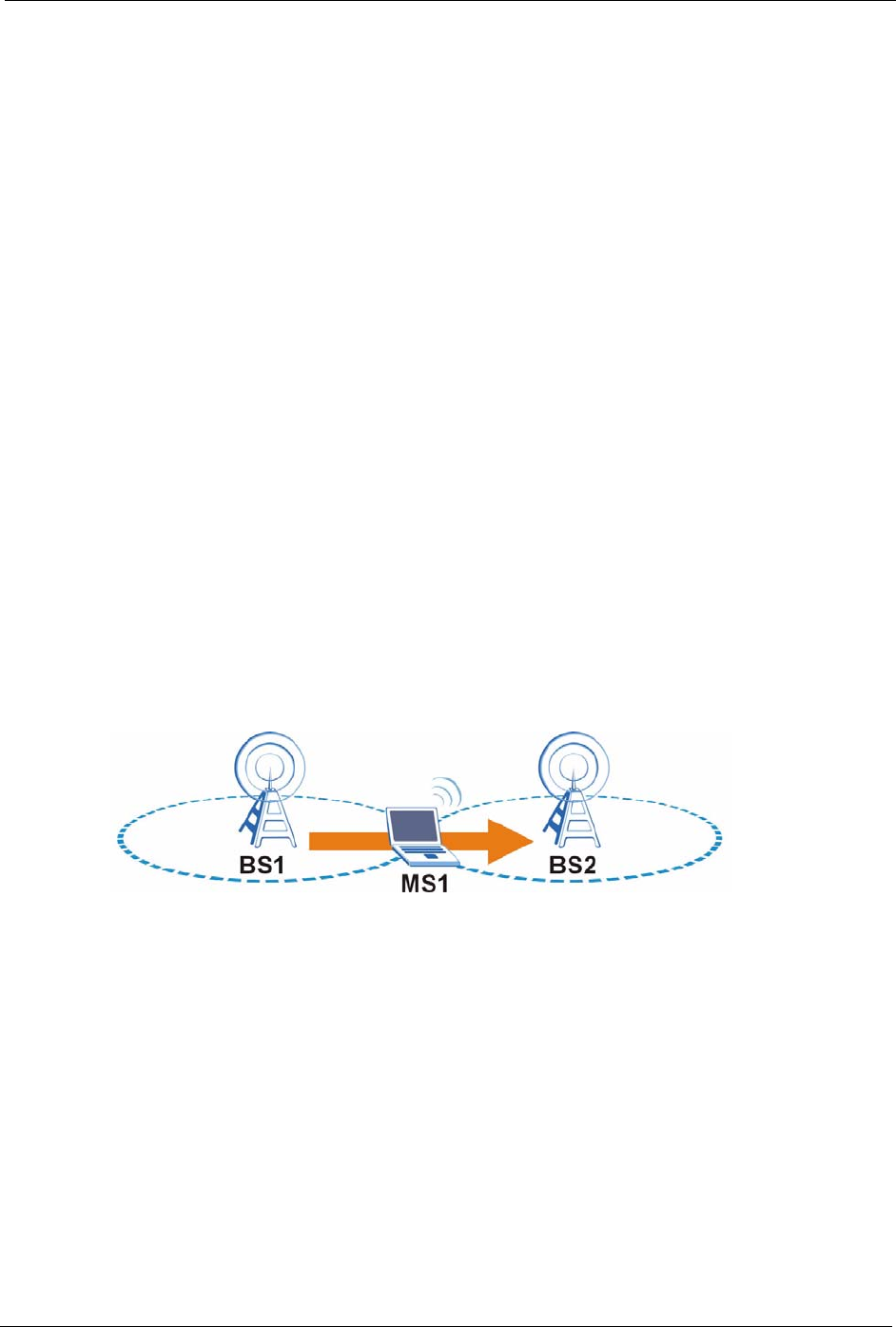
ZyXEL MAX-100 Series User’s Guide
Chapter 3 Wireless Configuration 27
CHAPTER 3
Wireless Configuration
This chapter discusses WiMAX and introduces each screen in the ZyXEL utility. See the
Quick Start Guide for hardware and utility installation procedures.
3.1 WiMAX Overview
WiMAX (Worldwide Interoperability for Microwave Access) is the IEEE 802.16 wireless
networking standard, which provides high-bandwidth, wide-range wireless service across
wireless Metropolitan Area Networks (MANs). ZyXEL is a member of the WiMAX Forum,
the industry group dedicated to promoting and certifying interoperability of wireless
broadband products.
In a wireless MAN, a wireless-equipped computer is known either as a mobile station (MS) or
a subscriber station (SS). Mobile stations use the IEEE 802.16e standard and are able to
maintain connectivity while switching their connection from one base station to another base
station (handover) while subscriber stations use other standards that do not have this capability
(IEEE 802.16-2004, for example). The following figure shows an MS-equipped notebook
computer MS1 moving from base station BS1’s coverage area and connecting to BS2.
Figure 8 WiMax: Mobile Station
WiMAX technology uses radio signals (around 2 to 10 GHz) to connect subscriber stations
and mobile stations to local base stations. Numerous subscriber stations and mobile stations
connect to the network through a single base station (BS), as in the following figure.
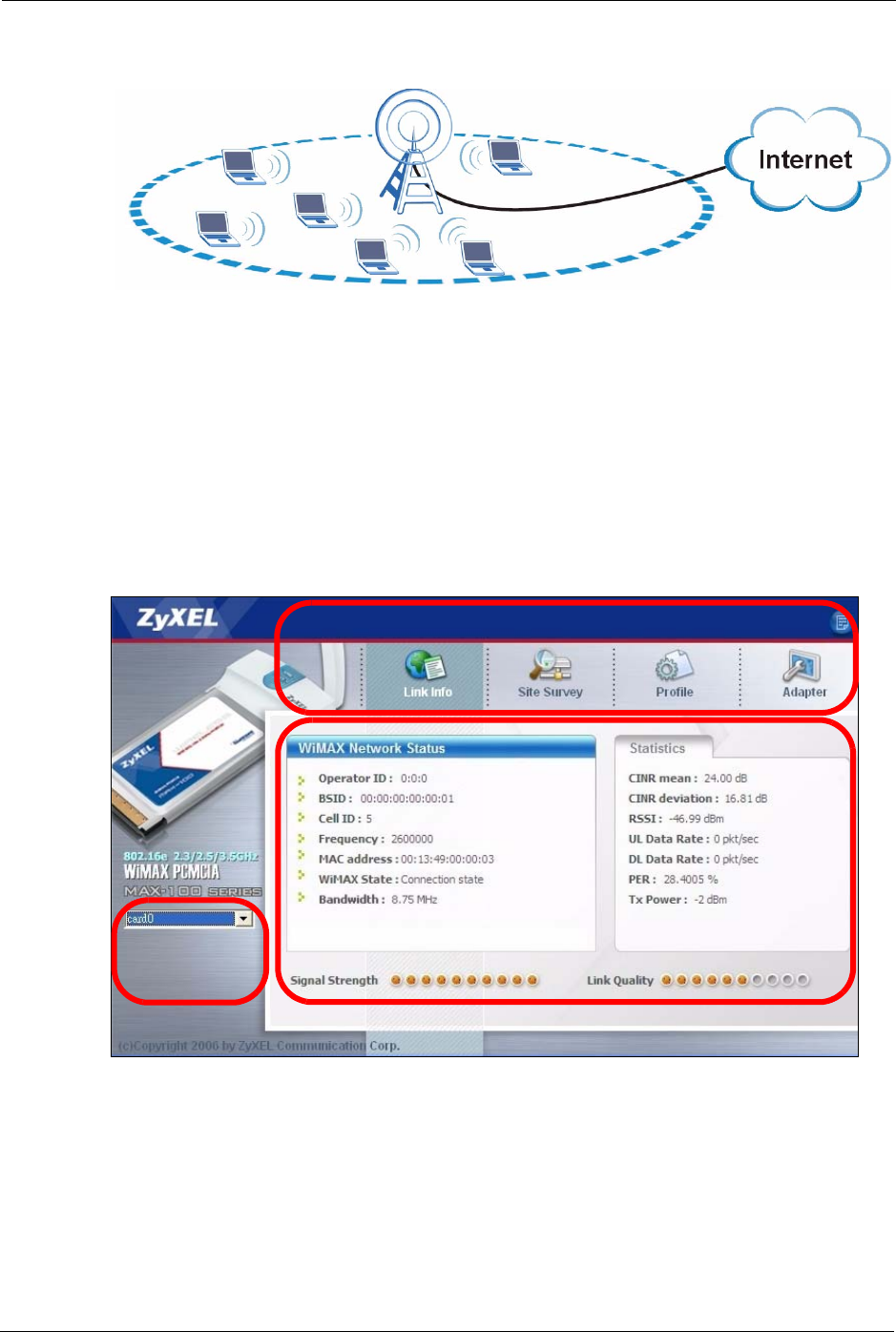
ZyXEL MAX-100 Series User’s Guide
28 Chapter 3 Wireless Configuration
Figure 9 WiMAX: Multiple Mobile Stations
A base station's coverage area can extend over many hundreds of meters, even under poor
conditions. A base station provides network access to subscriber stations and mobile stations,
and communicates with other base stations.
3.2 ZyXEL Utility Summary
This section describes the ZyXEL utility.
Figure 10 ZyXEL Utility Summary
B
A
C
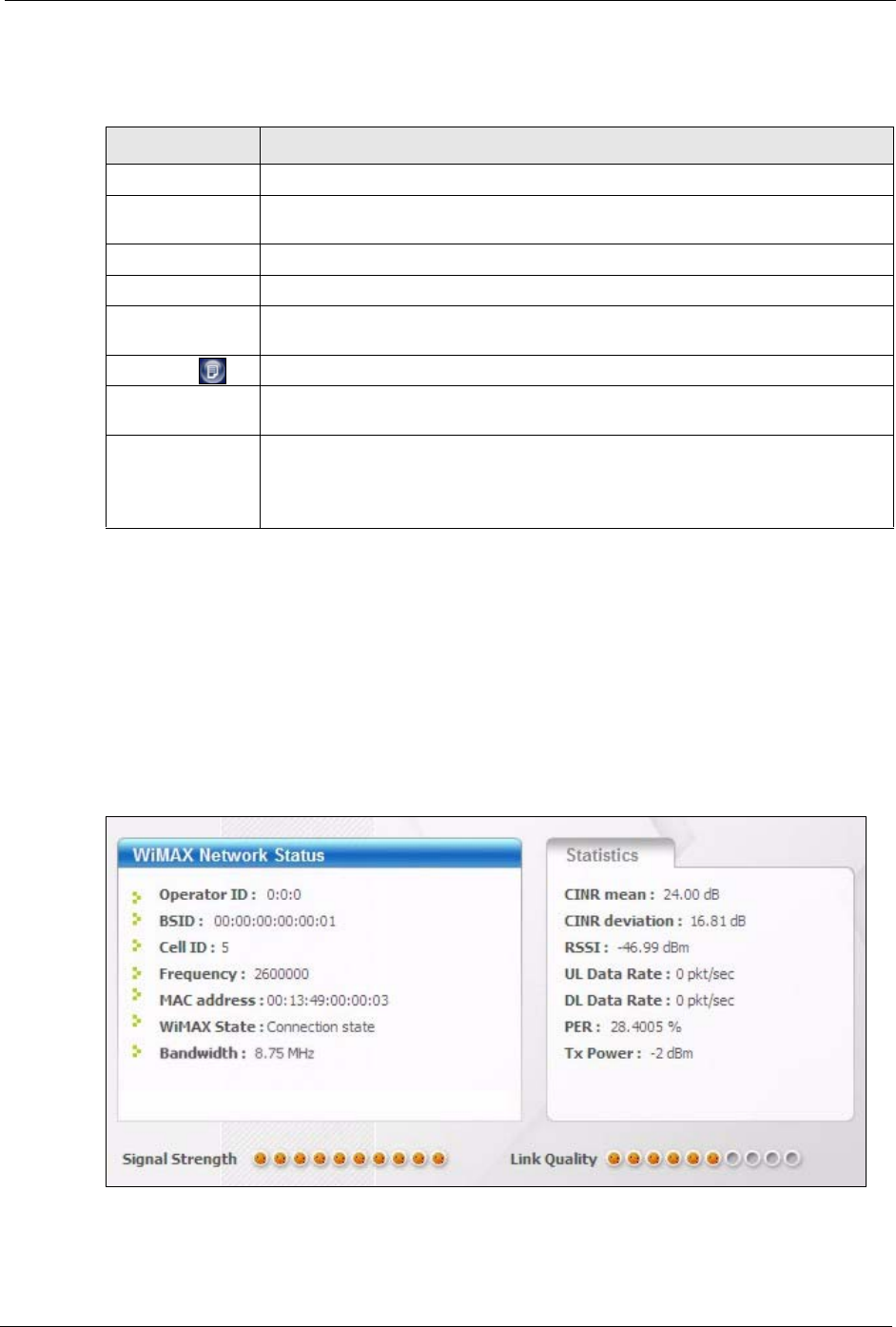
ZyXEL MAX-100 Series User’s Guide
Chapter 3 Wireless Configuration 29
The following table describes the labels in this screen.
3.3 The Link Info Screen
Use this screen to see your current connection status, configuration, and data rate statistics.
When the ZyXEL utility starts, the Link Info screen displays, showing the current
configuration and connection status of your ZyXEL Device. If the fields in this screen are
blank, the ZyXEL Device is not connected to a base station.
Figure 11 The Link Info Screen
Table 5 ZyXEL Utility Summary
LABEL DESCRIPTION
A Use these buttons to display the different screens in the utility.
Link Info Use this screen to see your current connection status, configuration, and data rate
statistics.
Site Survey Use these screens to configure wireless connection settings.
Profile Use this screen to configure wireless security and Internet access settings.
Adapter Use this screen to see your ZyXEL Device’s firmware version number, and to
upload new firmware.
About ( ) Click this button to see your ZyXEL Device’s driver and utility version number.
B Each utility screen displays here. When you first open the utility, the Link Info
screen displays.
C If you have more than one ZyXEL Device connected to your computer, use this list
to see details and configure settings of each ZyXEL Device currently connected.
The ZyXEL Device you first insert is Card0, the second ZyXEL Device you install is
Card1, etc.

ZyXEL MAX-100 Series User’s Guide
30 Chapter 3 Wireless Configuration
The following table describes the labels in this screen.
Table 6 The Link Info Screen
LABEL DESCRIPTION
WiMAX Network
Status
These fields provide information about the ZyXEL Device’s current network
connection status.
Operator ID Every WiMAX service provider has a unique Operator ID number, which is
broadcast by each base station it owns. You can only connect to the Internet
through base stations belonging to your service provider’s network.
BSID (Base
Station
IDentity)
This field displays the identification number of the wireless base station to which
the ZyXEL Device is connected. Every base station transmits a unique BSID, which
identifies it across the network.
Cell ID A base station’s coverage area can be divided into multiple cells. This field shows
the identification number of the cell in which the ZyXEL Device is connected. The
Cell ID is transmitted by the base station.
Frequency This field displays the radio frequency of the current wireless connection.
MAC address This field displays the Media Access Control (MAC) address of the ZyXEL Device.
Every network device has a unique MAC address which identifies it across the
network.
WiMAX State This field displays the status of the ZyXEL Device’s current connection.
•NA: the ZyXEL Device is starting up.
•Fail: The ZyXEL Device is unable to connect to a base station.
•Initial Synchronization: the ZyXEL Device is attempting to locate a base
station.
•Initial DCD (Downlink Channel Descriptor): the ZyXEL Device has located a
base station and is receiving information about a possible downlink connection.
•Initial UCD (Uplink Channel Descriptor): the ZyXEL Device is receiving
information from the base station about a possible uplink connection.
• Initial Ranging and Calibration: the ZyXEL Device and the base station are
transmitting and receiving information about the distance between them.
Ranging allows the ZyXEL Device to use a lower transmission power level
when communicating with a nearby base station, and a higher transmission
power level when communicating with a distant base station.
•Initial Negotiation: the ZyXEL Device and the base station are exchanging
information about their capabilities.
•Initial PKM (Privacy Key Management): the ZyXEL Device and the base
station are exchanging security information.
•Initial Registration: the ZyXEL Device is registering with a RADIUS server.
•Running: the ZyXEL Device has successfully registered with the base station.
Traffic can now flow between the ZyXEL Device and the base station.
•Sleep: the ZyXEL Device is in power saving mode, but periodically checks
whether a base station has traffic waiting.
•Idle: the ZyXEL Device is in power saving mode, but can connect when a base
station alerts it that there is traffic waiting.
•Handover: the ZyXEL Device is moving from one coverage area to another,
and is connecting to the new base station.
Bandwidth This field shows the size of the bandwidth step the ZyXEL Device uses to connect
to a base station in megahertz (MHz).
Statistics These fields provide information on the ZyXEL Device’s wireless signal status.

ZyXEL MAX-100 Series User’s Guide
Chapter 3 Wireless Configuration 31
3.4 Frequency Settings
In a WiMAX network, a mobile or subscriber station must use a radio frequency supported by
the base station to communicate. When the ZyXEL Device looks for a connection to a base
station, it searches a range of frequencies.
Radio frequency is measured in hertz (Hz), kilohertz (kHz), megahertz (MHz) and gigahertz
(GHz).
3.4.1 Frequency Ranges
The following figure shows the ZyXEL Device searching a range of frequencies to find a
connection to a base station.
CINR mean This field shows the average Carrier to Interference plus Noise Ratio (CINR) of the
current connection. This value is an indication of overall radio signal quality. A
higher value indicates a higher signal quality, and a lower value indicates a lower
signal quality.
CINR deviation This field shows the amount of change in the CINR level. This value is an indication
of radio signal stability. A lower number indicates a more stable signal, and a higher
number indicates a less stable signal.
RSSI This field shows the Received Signal Strength Indication (RSSI). This value is a
measurement of overall radio signal strength. A higher RSSI level indicates a
stronger signal, and a lower RSSI level indicates a weaker signal.
UL Data Rate This field shows the number of data packets uploaded from the ZyXEL Device to
the base station each second.
DL Data Rate This field shows the number of data packets downloaded to the ZyXEL Device from
the base station each second.
PER This field shows the Packet Error Rate (PER). The PER is the percentage of data
packets transmitted across the network but not successfully received.
Tx Power This field shows the output transmission (Tx) level of the ZyXEL Device.
Signal Strength This bar shows the current Received Signal Strength Indication (RSSI). Signal
strength depends mainly on the antenna output power and the distance between
your ZyXEL Device and the base station.
Link Quality This bar shows the quality of the wireless connection. This refers to the percentage
of packets transmitted successfully. If there are too many wireless stations in a
wireless network, collisions may occur which could result in a loss of messages
even though you have high signal strength.
Table 6 The Link Info Screen (continued)
LABEL DESCRIPTION
Table 7 Radio Frequency Conversion
1 kHz = 1000 Hz
1 MHz = 1000 kHz (1000000 Hz)
1 GHz = 1000 MHz (1000000 kHz)
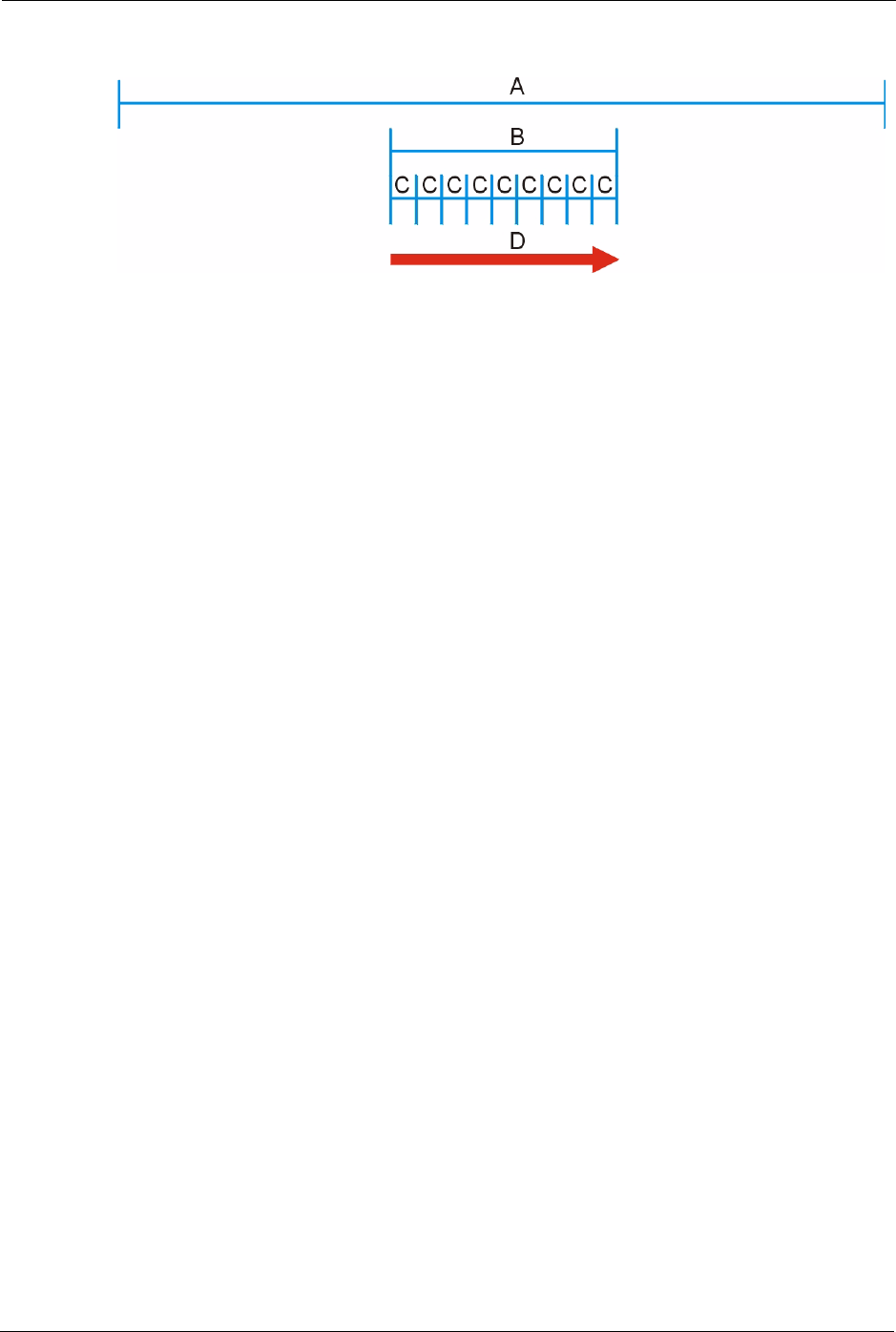
ZyXEL MAX-100 Series User’s Guide
32 Chapter 3 Wireless Configuration
Figure 12 Frequency Ranges
In this figure, A is the WiMAX frequency range. “WiMAX frequency range” refers to the
entire range of frequencies the ZyXEL Device is capable of using to transmit and receive (see
the Product Specifications appendix for details).
In the figure, B shows the operator frequency range. This is the range of frequencies within the
WiMAX frequency range supported by your operator (service provider).
The operator range is subdivided into bandwidth steps. In the figure, each C is a bandwidth
step.
The arrow D shows the ZyXEL Device searching for a connection.
Have the ZyXEL Device search only certain frequencies by configuring the downlink
frequencies. Your operator can give you information on the supported frequencies.
The downlink frequencies are points of the frequency range your ZyXEL Device searches for
an available connection. Use the site survey screen to set these bands. You can set the
downlink frequencies anywhere within the WiMAX frequency range. In this example, the
downlink frequencies have been set to search all of the operator range for a connection.
3.5 The Site Survey Screen
Click the Site Survey tab. Use these screens to configure wireless connection settings.
When you want to have the ZyXEL Device search for a connection to a base station, you have
the following options.
• Use the Manual site survey screen to type in settings yourself. Do this if you want to
configure the ZyXEL Device to scan frequencies that are not in a range (for example,
2.55 GHz, 2.525 GHz, 2.65GHz and 2.675 GHz). See Section 2.1 on page 23 for an
example of using the Manual screen.
or

ZyXEL MAX-100 Series User’s Guide
Chapter 3 Wireless Configuration 33
• Use the Express site survey screen to set the ZyXEL Device to scan a specified range of
frequencies automatically. Do this if your service provider has given you details of an
available frequency range in your region (for example, 2.55 ~ 2.6 GHz with a bandwidth
step of 25MHz). See Section 3.5.2.1 on page 35 for an example of using the Express
screen.
3.5.1 Site Survey: Manual
Use this screen to define radio frequencies to be searched for available wireless connections.
• The ZyXEL Device searches the DL Frequency settings in ascending numerical order,
from [1] to [9].
• If you enter a 0 in a DL Frequency field, the ZyXEL Device immediately moves on to
the next DL Frequency field.
• When the ZyXEL Device connects to a base station, the values in this screen are
automatically set to the base station’s frequency. The next time the ZyXEL Device
searches for a connection, it searches only this frequency. If you want the ZyXEL Device
to search other frequencies, enter them in the DL Frequency fields.
The following table describes some examples of DL Frequency settings.
Table 8 DL Frequency Example Settings
EXAMPLE 1 EXAMPLE 2
DL Frequency [1]: 2500000 2500000
DL Frequency [2]: 2550000 2550000
DL Frequency [3] 0 2600000
DL Frequency [4: 00
DL Frequency [5]: 00
The ZyXEL Device
searches at 2500000 kHz,
and then searches at
2550000 kHz if it has not
found a connection.
The ZyXEL Device
searches at 2500000 kHz
and then at 2550000 kHz
if it has not found an
available connection. If it
still does not find an
available connection, it
searches at 2600000 kHz.
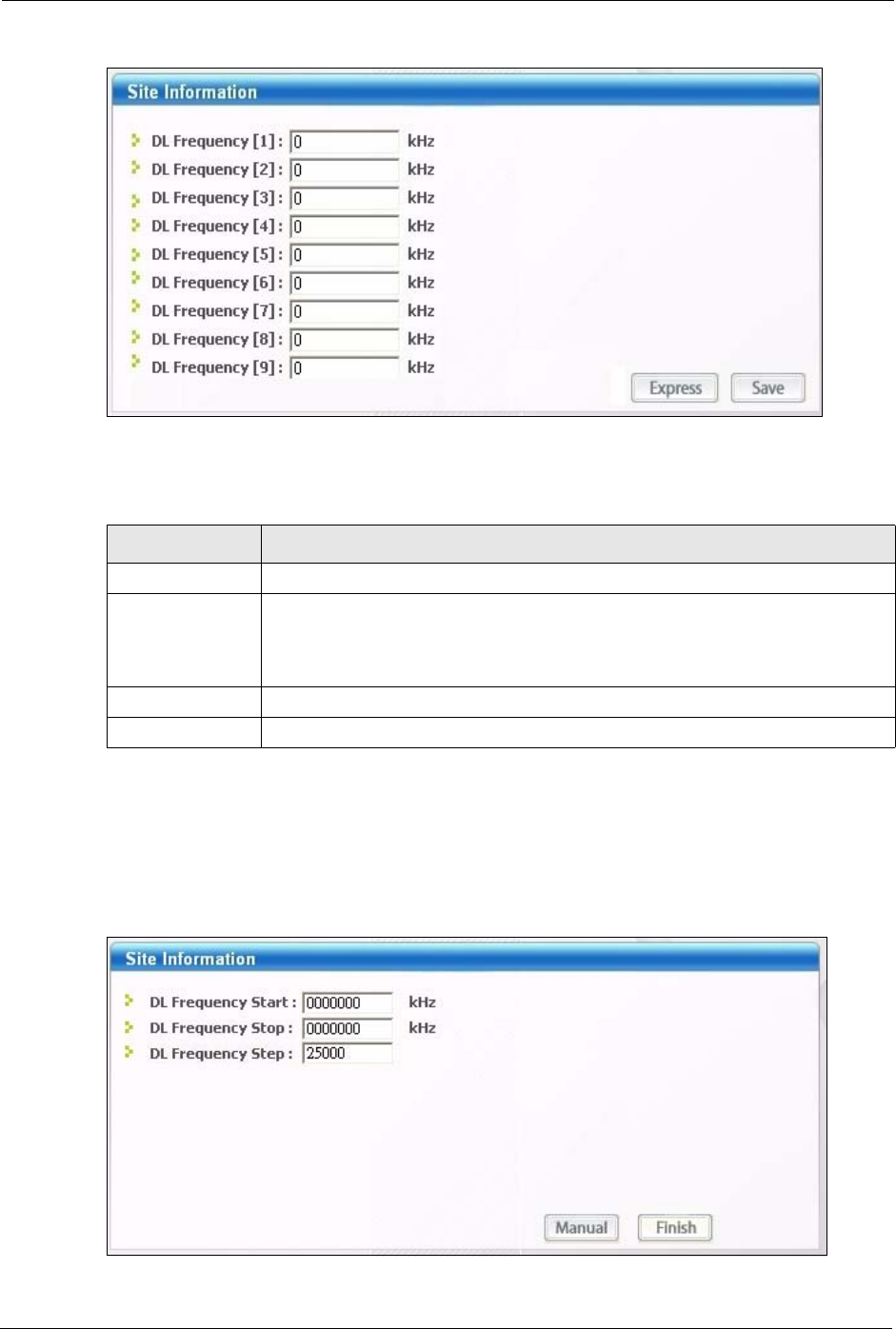
ZyXEL MAX-100 Series User’s Guide
34 Chapter 3 Wireless Configuration
Figure 13 The Site Survey Screen (manual)
The following table describes the labels in this screen.
3.5.2 Site Survey: Express
Click Site Survey > Express. Use this screen to set the ZyXEL Device to automatically search
a range of frequencies for an available connection to a base station.
Figure 14 The Site Survey Screen (Express)
Table 9 The Site Survey Screen (Manual)
LABEL DESCRIPTION
Site Information
DL Frequency
[1-9]
These fields show the downlink frequency settings in kilohertz (kHz). Enter values
in these fields to have the ZyXEL Device scan these frequencies for available
channels in ascending numerical order.
Contact your service provider for details of supported frequencies.
Express Click this button to go to the Express site survey screen.
Save Click this button to save your wireless settings.

ZyXEL MAX-100 Series User’s Guide
Chapter 3 Wireless Configuration 35
The following table describes the labels in this screen.
3.5.2.1 Using the Site Survey Screen (Express): Example
In this example, your Internet service provider has given you a range of supported frequencies,
as follows.
You have chosen to use the Express site survey screen, as you have a single frequency range
to search for a connection.
1You need to enter the frequency settings your ISP gave you. 1GHz is equal to 1000000
kilohertz (kHz), so enter “2525000” in the DL Frequency Start field and enter
“2600000” in the DL frequency Stop field.
The ZyXEL Device splits this range of frequencies into (at most) eight bands between
DL Frequency Start and DL Frequency Stop (this gives nine search points). The gap
between these points is controlled by the DL Frequency Step value. The ZyXEL Device
searches each of the points (the blue lines in the following figure) for a connection as
shown.
Table 10 The Site Survey Screen (Express)
LABEL DESCRIPTION
DL Frequency Start Use this field to set the low end of the frequency range (in kilohertz).
DL Frequency Stop Use this field to set the high end of the frequency range (in kilohertz).
DL Frequency Step Use this field to set the step size between DL Frequency values (in kilohertz).
The step size is the difference between two adjacent DL Frequency values.
The Site Survey (Express) screen automatically creates a maximum of nine
frequency bands. Therefore, make sure that the DL Frequency Step setting is
no less than one-ninth of the difference between the DL Frequency start and
DL Frequency stop values.
Manual Click this button to return to the Manual site survey screen. Your settings in
the Express screen will not be saved.
Finish Click this button to return to the Manual screen. Your settings will be displayed
in the DL frequency [1-9] fields. You still need to save your settings.
Table 11 Example Supported Frequencies (GHz)
Start 2.525
Stop 2.6
Table 12 Example Frequency Settings
Start 2.525 GHz = 2525000 kHz
Stop 2.6 GHz = 2600000 kHz
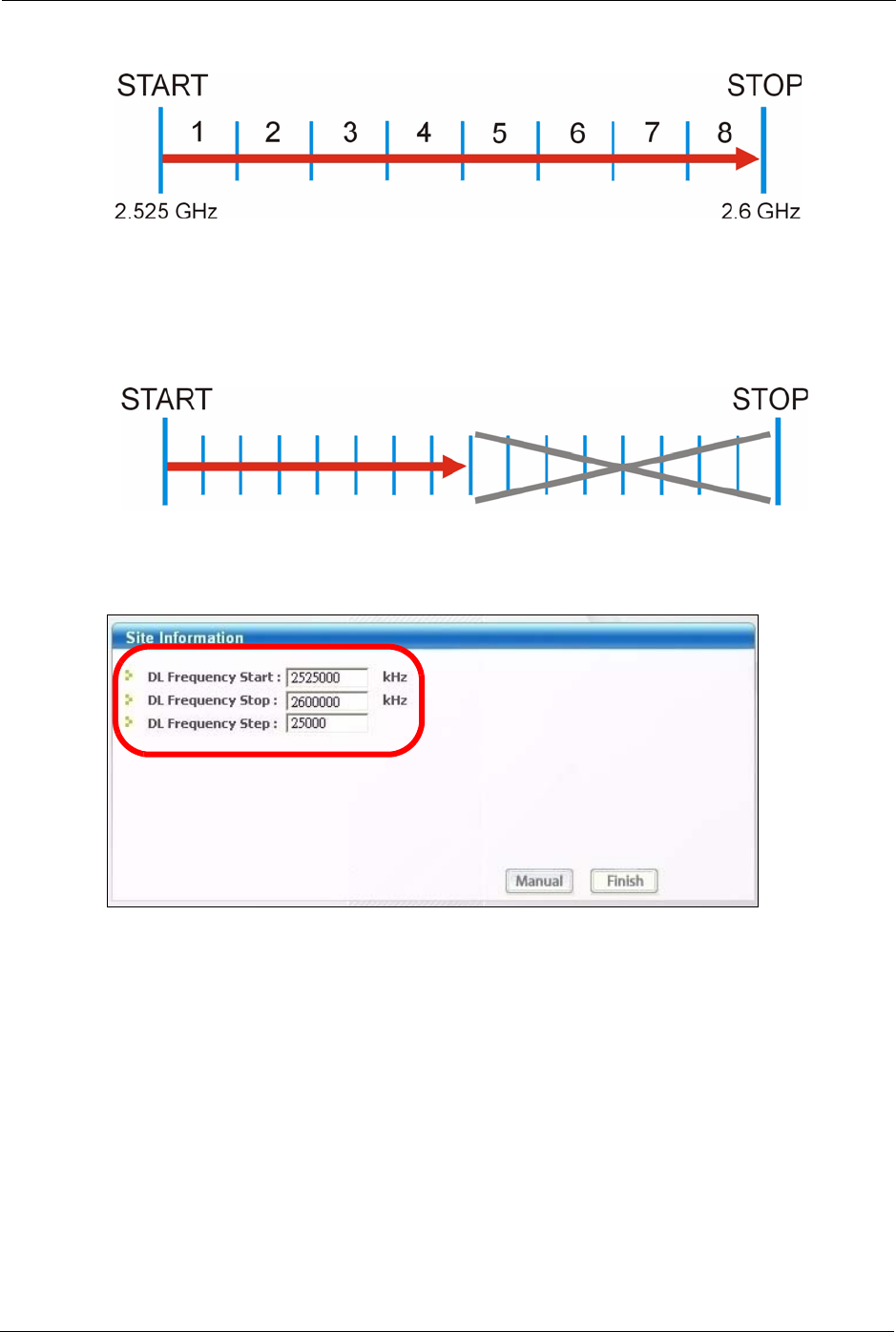
ZyXEL MAX-100 Series User’s Guide
36 Chapter 3 Wireless Configuration
Figure 15 Search Example 1
The ZyXEL Device uses only the first nine points between DL Frequency Start and DL
Frequency Stop, so if the DL Frequency Step is too small the rest of the range is not
searched, as in the following figure. The arrow shows the ZyXEL Device searching the
first nine points, and the cross shows the points that are not searched.
Figure 16 Search Example 2
2Your ISP gave you 25 MHZ as the downlink frequency step, so leave the DL Frequency
Step field at its default (25 MHz = 25000 kHz).
Figure 17 Frequency Values
3Click Finish to return to the Manual screen. The DL Frequency fields have been
automatically filled in.
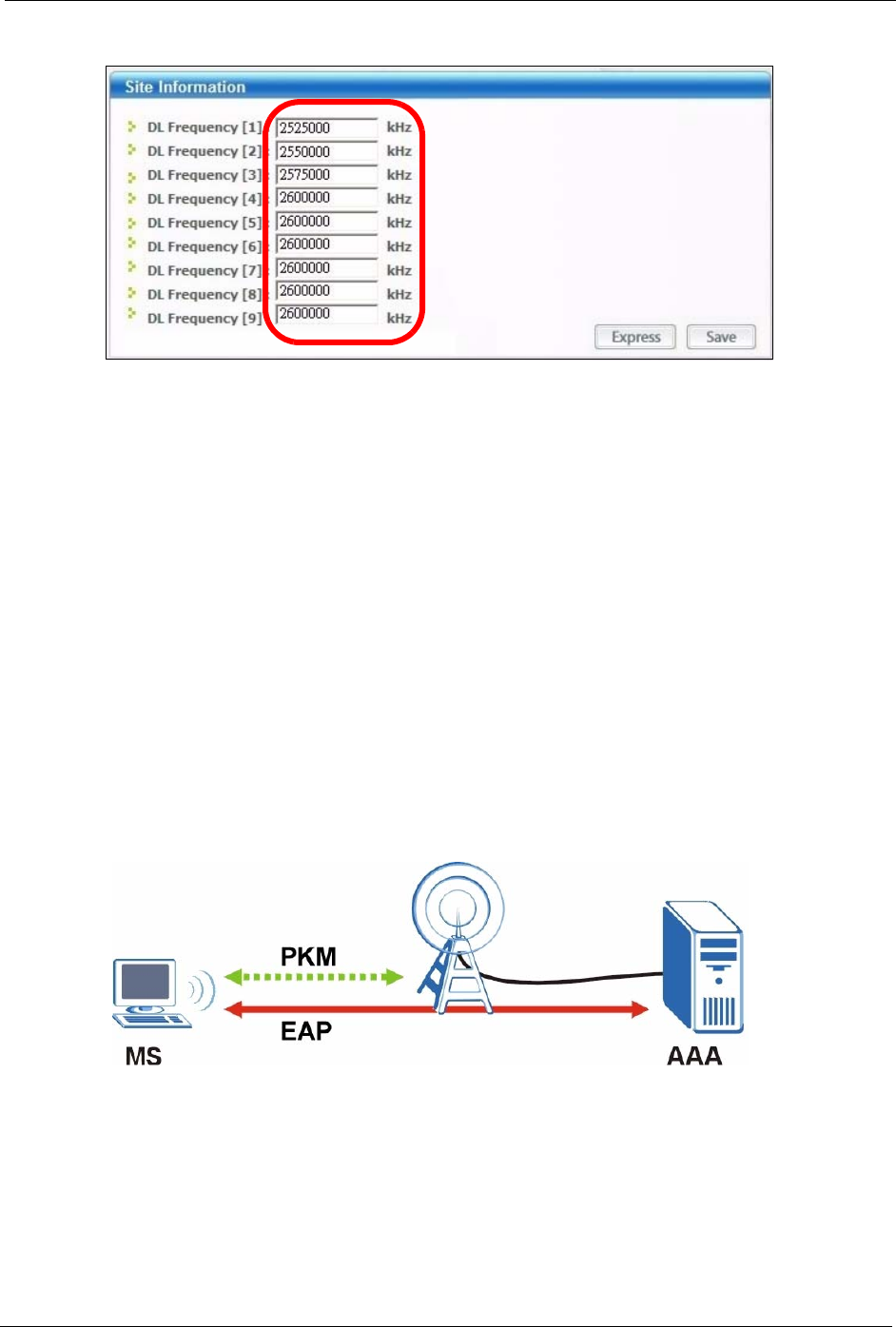
ZyXEL MAX-100 Series User’s Guide
Chapter 3 Wireless Configuration 37
Figure 18 Automatic Completion
4Click Save to save your settings to the ZyXEL Device. The ZyXEL Device scans for a
connection in the order on the screen. When it finds one, the fields in this screen are
automatically set to use that frequency.
3.6 Authentication
When authenticating a user, the base station uses a third-party RADIUS or Diameter server
known as an AAA (Authentication, Authorization and Accounting) server to authenticate the
mobile or subscriber stations.
WiMAX uses PKM (Privacy Key Management) for authentication between the mobile or
subscriber station and the base station, and supports EAP (Extensible Authentication Protocol)
between the mobile or subscriber station, the base station, and the AAA server.
The following figure shows a base station using an AAA server to authenticate mobile station
MS, allowing it to access the Internet.
Figure 19 Authentication
In this figure, the dashed arrow shows the PKM secured connection between the mobile
station and the base station, and the solid arrow shows the EAP secured connection between
the mobile station, the base station and the AAA server. See the WiMAX security appendix for
more details.
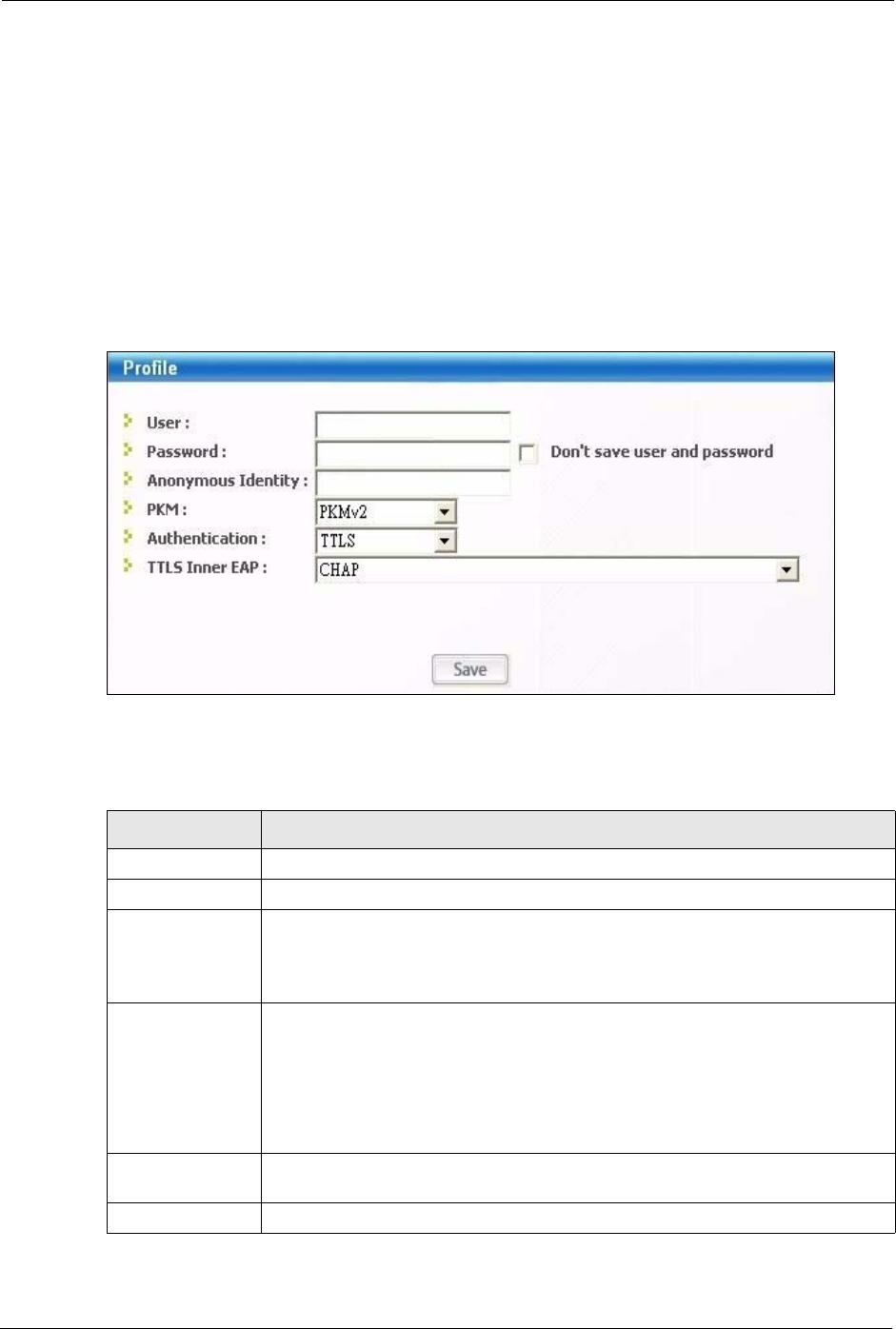
ZyXEL MAX-100 Series User’s Guide
38 Chapter 3 Wireless Configuration
3.7 The Profile Screen
Click the Profile tab. Use this screen to configure wireless security and Internet access
settings.
A profile is a set of wireless parameters that you need to connect to a wireless network. Use
the settings given to you by your Internet service provider.
If you do not configure the profile, each time you start the ZyXEL Device it uses the default
user name and password to try to connect to any available network.
Figure 20 The Profile Screen
The following table describes the labels in this screen.
Table 13 The Profile Screen
LABEL DESCRIPTION
User Enter the user name associated with your Internet access account.
Password Enter the password associated with your Internet access account.
Don’t save user
and password
Select this box if you want to enter your user name and password every time you
use the ZyXEL Device on this computer.
If you do not select this box, anyone using the ZyXEL Device on this computer can
use your Internet account to access the Internet.
Anonymous
Identity
Enter the anonymous identity provided by your Internet Service Provider.
Anonymous identity (also known as outer identity) is used with EAP-TTLS
encryption. The anonymous identity is used to route your authentication request to
the correct authentication server, and does not reveal your real user name. Your
real user name and password are encrypted in the TLS tunnel, and only the
anonymous identity can be seen.
Leave this field blank if your ISP did not give you an anonymous identity to use.
PKM This field displays the Privacy Key Management version number. See the WiMAX
security appendix for more information.
Authentication This field displays the user authentication method.
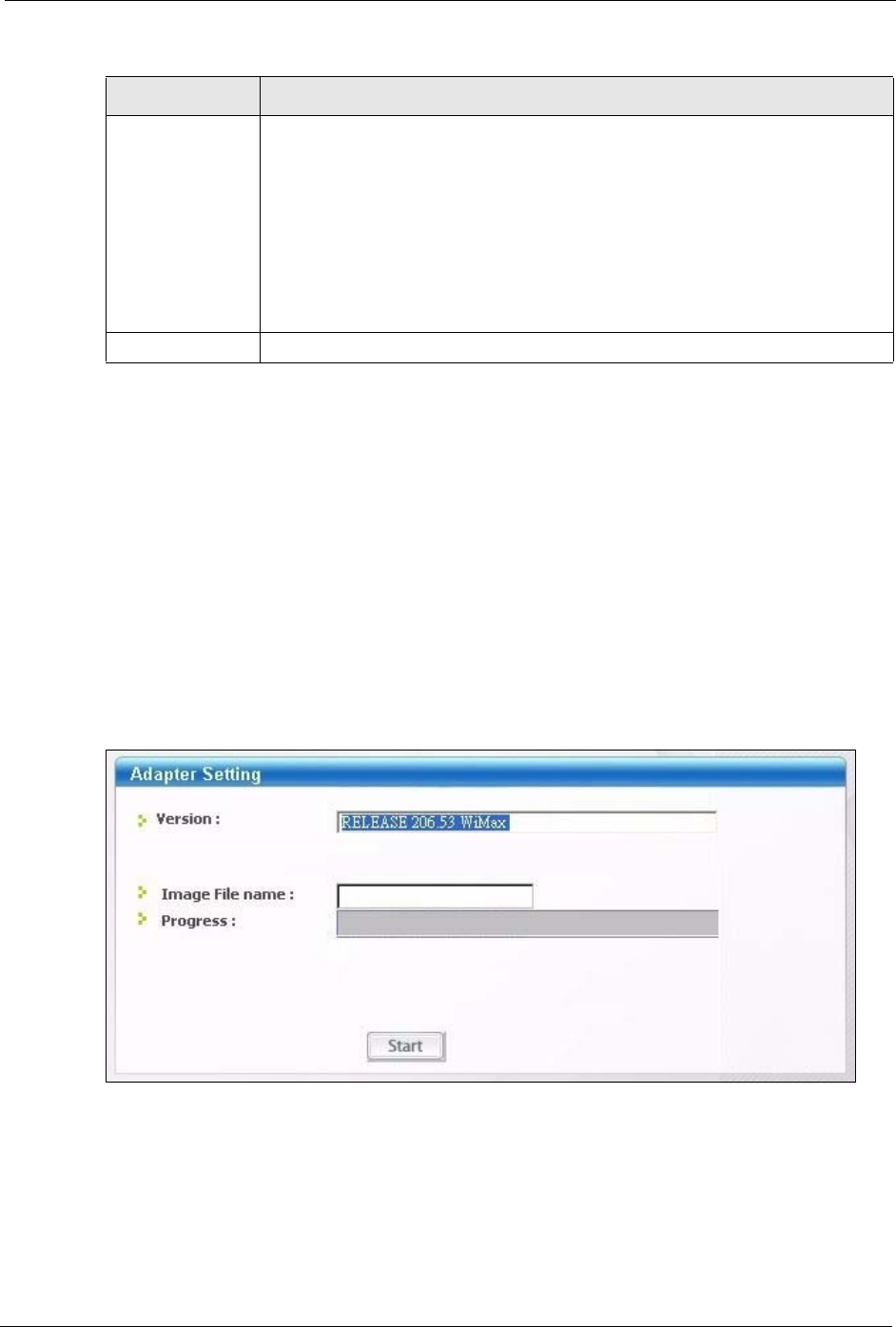
ZyXEL MAX-100 Series User’s Guide
Chapter 3 Wireless Configuration 39
3.8 The Adapter Screen
Click the Adapter tab. Use this screen to see your ZyXEL Device’s firmware version number,
and to upload new firmware.
The firmware determines the device’s available features and functionality. You can download
new firmware releases from your nearest ZyXEL FTP site (or www.zyxel.com) to use to
upgrade your device’s performance.
Note: Only use firmware for your device’s specific model. Refer to the label on your
ZyXEL Device.
Figure 21 The Adapter Screen
TTLS Inner EAP Select the type of inner authentication to be used from the drop-down list box.
Check with your service provider if you are unsure of the correct setting for your
account.
The ZyXEL Device supports the following inner authentication types:
•CHAP (Challenge Handshake Authentication Protocol)
•EAP (Extensible Authentication Protocol)
•MSCHAP (Microsoft CHAP)
•MSCHAP2 (Microsoft CHAP version2)
•PAP (Password Authentication Protocol)
Save Click this button to save your profile settings.
Table 13 The Profile Screen (continued)
LABEL DESCRIPTION
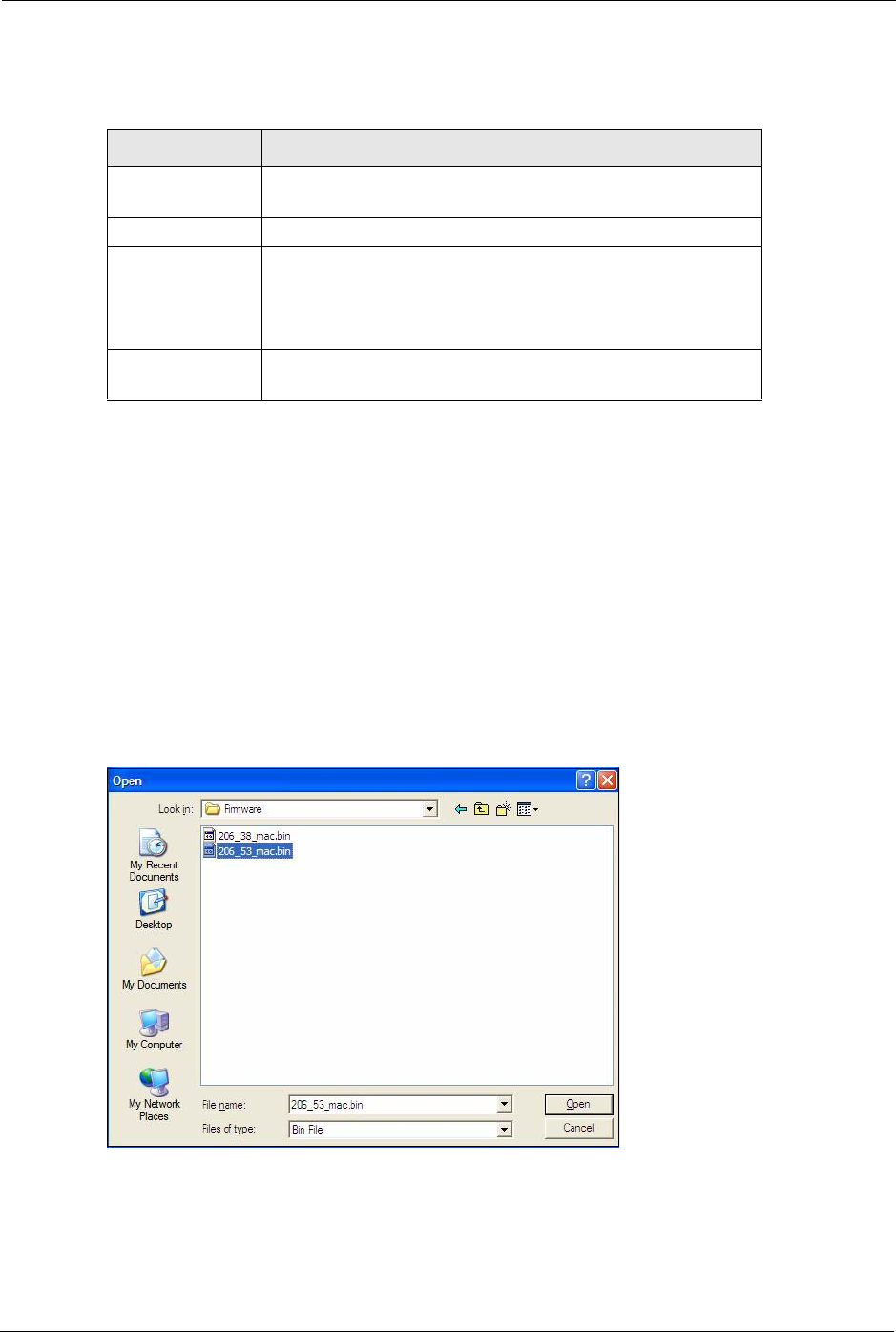
ZyXEL MAX-100 Series User’s Guide
40 Chapter 3 Wireless Configuration
The following table describes the labels in this screen.
3.8.1 Uploading Firmware
Take the following steps to upload new firmware to the ZyXEL Device.
1Save the new firmware in the ZyXEL Device’s directory on your computer. The default
directory is C:\Program Files\ZyXEL\MAX-100 Series\.
If the firmware is in a compressed (.zip) file, you need to decompress (unzip) it. The
ZyXEL Device firmware is a binary (.bin) file.
2Open the ZyXEL Device utility and click the Adapter tab. Click Start when you are
ready to upload. A window similar to the following appears.
Figure 22 Adapter: Upload Firmware
3Locate the firmware file and click Open.
4The firmware’s filename appears in the Image File Name field. The progress bar
displays how much of the file has uploaded. This may take several minutes.
Table 14 The Adapter Screen
LABEL DESCRIPTION
Version This is the version number of the firmware the ZyXEL Device is
currently using.
Image File Name This shows the file name of the firmware you are uploading.
Progress This shows the amount of the firmware file that has been
uploaded.
Note: Do not turn off or remove the ZyXEL Device
while firmware upload is in progress!
Start Click this to select a firmware file and upload it to the ZyXEL
Device.

ZyXEL MAX-100 Series User’s Guide
Chapter 3 Wireless Configuration 41
Note: Do NOT unplug your ZyXEL Device or turn off the computer while firmware
upload is in progress! This may PERMANENTLY DAMAGE your device!
5When the upload is finished, restart your ZyXEL Device (unplug it then plug it back in).
Open the utility and click the Adapter tab. Check that the Version field displays the
filename of the new firmware.

ZyXEL MAX-100 Series User’s Guide
42 Chapter 3 Wireless Configuration
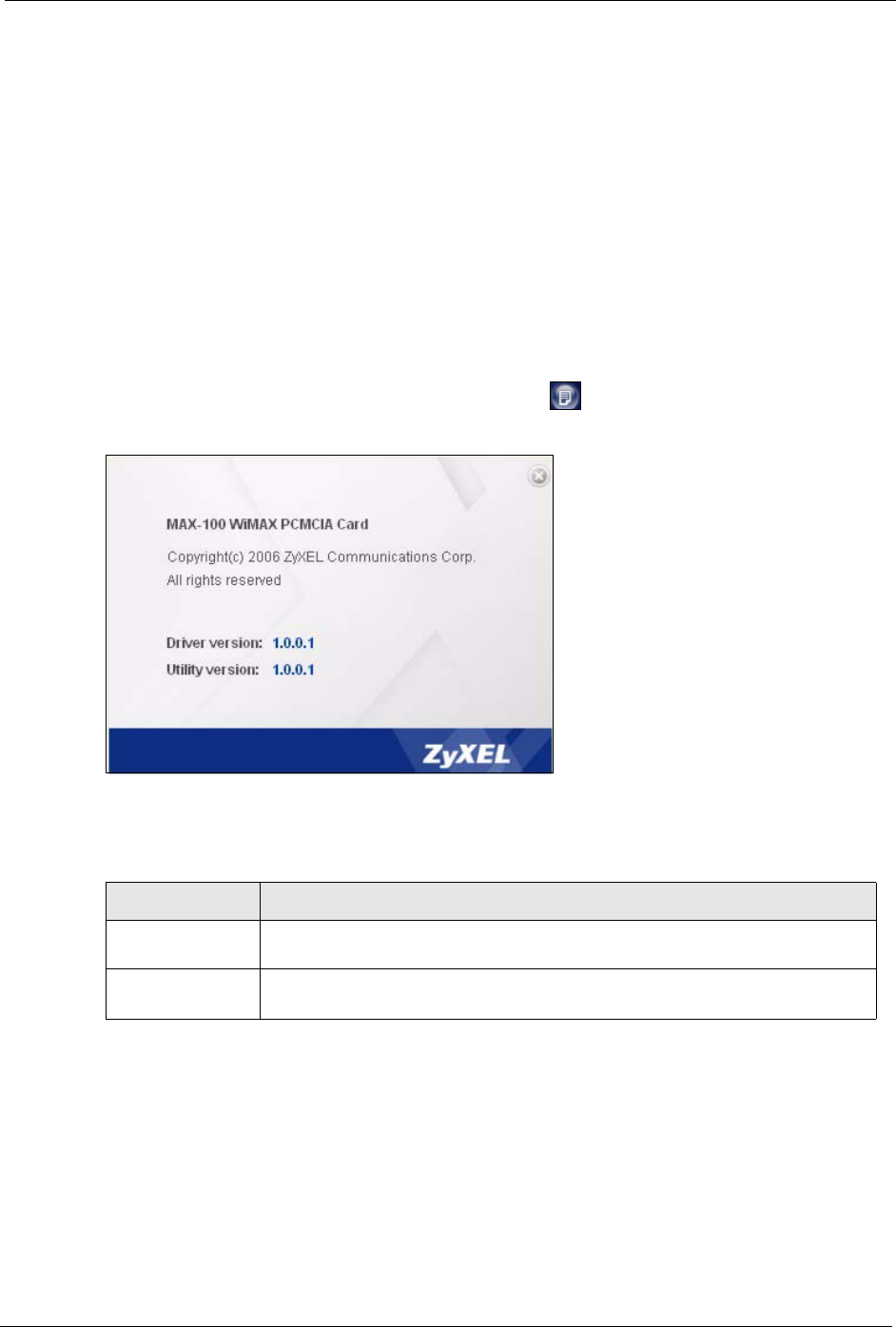
ZyXEL MAX-100 Series User’s Guide
Chapter 4 Maintenance 43
CHAPTER 4
Maintenance
This chapter describes the About screen and how to uninstall or upgrade the ZyXEL utility.
4.1 The About Screen
The About screen displays the driver and utility version numbers of the ZyXEL Device. To
display the screen as shown below, click the About ( ) button.
Figure 23 About
The following table describes the read-only fields in this screen.
4.2 Uninstalling the ZyXEL Utility
Follow the steps below to remove (or uninstall) the ZyXEL utility from your computer.
Note: Before you uninstall the ZyXEL utility, make a copy of your current wireless
configurations.
Table 15 About
LABEL DESCRIPTION
Driver version This field displays the version number of the ZyXEL Device driver. The driver is a
piece of software your computer needs to communicate with the ZyXEL Device.
Utility version This field displays the version number of the ZyXEL utility. The ZyXEL utility is
software you use to configure your ZyXEL Device.
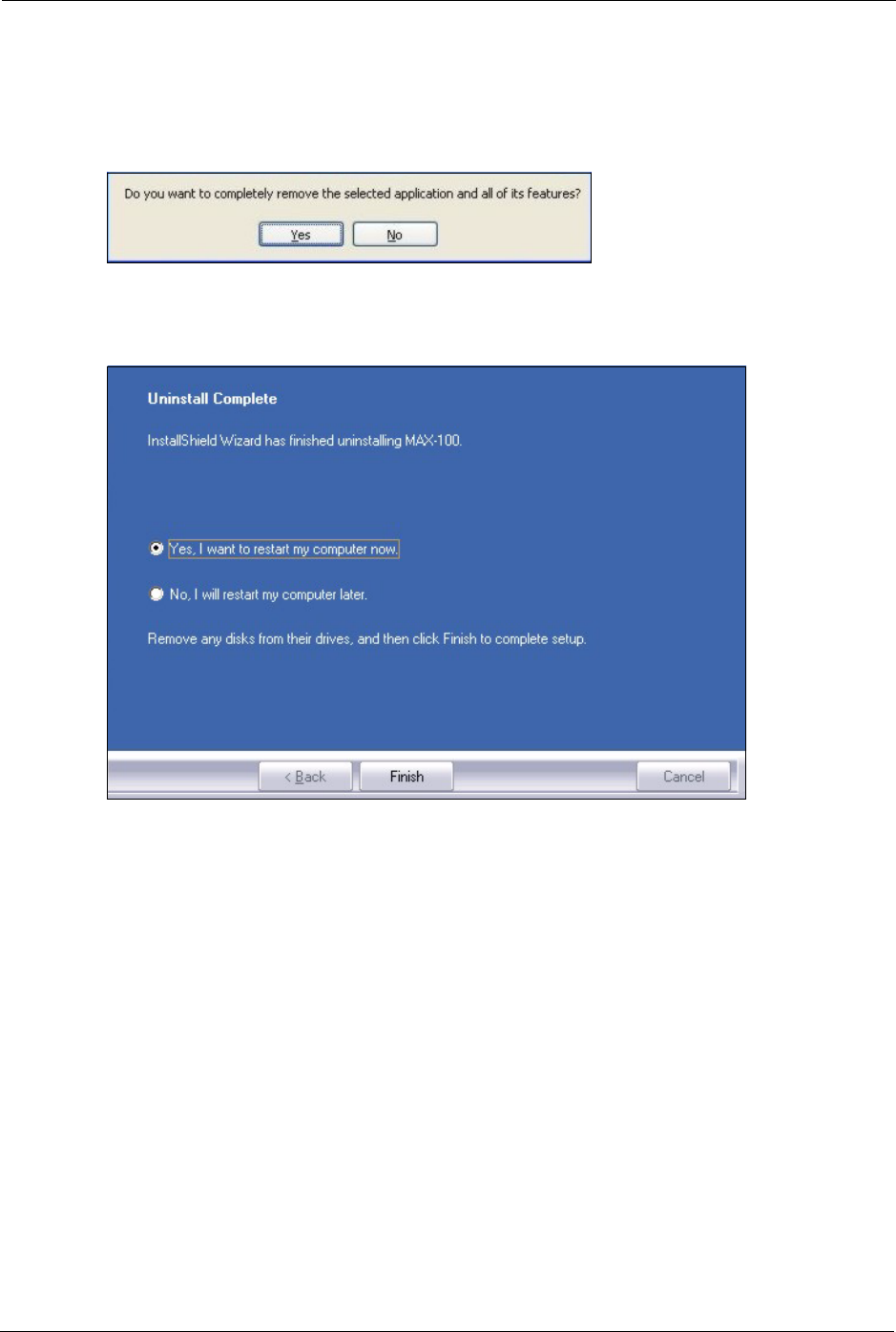
ZyXEL MAX-100 Series User’s Guide
44 Chapter 4 Maintenance
1Click Start, (All) Programs, ZyXEL ZyXEL Device Utility, Uninstall ZyXEL ZyXEL
Device Utility.
2When prompted, click OK or Yes to remove the driver and the utility software.
Figure 24 Uninstall: Confirm
3Click Finish to complete uninstalling the software and restart the computer when
prompted.
Figure 25 Uninstall: Finish
4.3 Upgrading the ZyXEL Utility
To perform the upgrade, follow the steps below.
1Download the latest version of the utility from the ZyXEL web site and save the file on
your computer.
Note: Before you uninstall the ZyXEL utility, make a copy of your current wireless
configurations.
2Follow the steps in Section 4.2 on page 43 to remove the current ZyXEL utility from your
computer. Restart your computer when prompted.
3Disconnect the ZyXEL Device from your computer.
4Double-click on the setup program for the new utility to start the ZyXEL utility
installation.

ZyXEL MAX-100 Series User’s Guide
Chapter 4 Maintenance 45
5Insert the ZyXEL Device and check the version numbers in the About screen to make
sure the new utility is installed properly.

ZyXEL MAX-100 Series User’s Guide
46 Chapter 4 Maintenance

ZyXEL MAX-100 Series User’s Guide
Chapter 5 Troubleshooting 47
CHAPTER 5
Troubleshooting
This chapter covers potential problems and the possible remedies. After each problem
description, some instructions are provided to help you to diagnose and to solve the problem.
5.1 Problems Starting the ZyXEL Utility
5.2 Problems Connecting to the Internet
Table 16 Troubleshooting Starting the ZyXEL Utility
PROBLEM CORRECTIVE ACTION
Cannot start the
ZyXEL utility
Make sure the ZyXEL Device is properly inserted and the PWR LED is on.
Use the Device Manager to check for possible hardware conflicts. Click Start,
Settings, Control Panel, System, Hardware and Device Manager. Verify the
status of the ZyXEL Device under Network Adapter. (Steps may vary depending
on the version of Windows).
Install the ZyXEL utility and the ZyXEL Device in another computer and attempt to
start the utility.
If the error persists, you may have a hardware problem. In this case, you should
contact your local vendor.
The ZyXEL utility
icon does not
display.
Restart your computer and insert the ZyXEL Device. If the icon still does not
display, uninstall (remove) and re-install the ZyXEL utility.
Table 17 Troubleshooting Internet Connection
PROBLEM CORRECTIVE ACTION
I cannot access
the Internet.
Check your connection. Open the ZyXEL utility and check the Link Info screen. If
the ZyXEL Device cannot detect a signal, you are not connected to a base station.
Use the following steps to make sure you are using the correct settings.
Check your security settings. Open the Profile screen in the ZyXEL utility and
make sure that you are using the correct security settings for your Internet
account.
Check your frequency settings. The ZyXEL Device may have been set to search
the wrong frequencies for a wireless connection. Open the Site Survey screen in
the ZyXEL utility and ensure that the values are correct. If you are unsure of the
correct values, contact your service provider.
Check your IP settings. You may be using IP address settings incompatible with
your Internet account. If you are unsure of the correct settings, contact your service
provider. See Appendix C on page 55 for information on how to set up your IP
address.

ZyXEL MAX-100 Series User’s Guide
48 Chapter 5 Troubleshooting
5.3 Problems with the Link Quality
Table 18 Troubleshooting Link Quality
PROBLEM CORRECTIVE ACTION
Internet access is
slow or
intermittent.
The quality of the ZyXEL Device’s wireless connection to the base station may be
poor.
Use the Link Info screen in the ZyXEL utility to see information about your
wireless connection.
Poor signal reception may be improved by changing the position of the antenna, or
moving the ZyXEL Device away from thick walls and other obstructions or to a
higher floor in your building.
There may be radio interference caused by nearby electrical devices such as
microwave ovens and radio transmitters. Move the ZyXEL Device away or switch
the other devices off.
Weather conditions may also affect signal quality.

ZyXEL MAX-100 Series User’s Guide
Appendix A 49
APPENDIX A
Product Specifications
Table 19 Product Specifications
PHYSICAL AND ENVIRONMENTAL
Product Name ZyXEL MAX-100 Series WiMAX PCMCIA Card
Interface 3.3V 16-bit PCMCIA card
Standards IEEE 802.16e-2005
Antenna 1 X 2dBi omni dipole antenna
Operating Temperature 0 ~ 45 degrees C
Storage Temperature -25 ~ 55 degrees C
Operating Humidity 10% ~ 90% (non-condensing)
Storage Humidity 10% ~ 95%
Power Maximum 2W
Dimensions 58 x 125 x 10mm
RADIO SPECIFICATIONS
Media Access Protocol IEEE 802.16e
WiMAX Frequency Range MAX-100: 2.5 ~ 2.7 GHz
MAX-110: 3.4 ~ 3.6 GHz
MAX-130: 2.3 ~ 2.4 GHz
Data Rate Downlink: Maximum 5Mbps
Uplink: Maximum 2Mbps
Modulation QPSK (upload and download)
16-QAM (upload and download)
64-QAM (download only)
Output Power 23dBm (+/- 1dB)
Duplex mode Time Division Duplex (TDD)
SOFTWARE SPECIFICATIONS
Device Drivers Windows 2000 (Service Pack 4 or later)
Windows XP (Service Pack 2 or later)
Security PKMv2
EAP
CCMP, 128-bit AES
System Requirements Pentium II 300 MHz or above
PCMCIA port
Minimum 20 MB available hard disk space
Minimum 32 MB RAM
CD-ROM drive

ZyXEL MAX-100 Series User’s Guide
50 Appendix A

ZyXEL MAX-100 Series User’s Guide
51
APPENDIX B
WiMAX Security
Wireless security is vital to protect your wireless communications. Without it, information
transmitted over the wireless network would be accessible to any networking device within
range.
User Authentication and Data Encryption
The WiMAX (IEEE 802.16) standard employs user authentication and encryption to ensure
secured communication at all times.
User authentication is the process of confirming a user’s identity and level of authorization.
Data encryption is the process of encoding information so that it cannot be read by anyone
who does not know the code.
WiMAX uses PKMv2 (Privacy Key Management version 2) for authentication, and CCMP
(Counter Mode with Cipher Block Chaining Message Authentication Protocol) for data
encryption.
WiMAX also supports EAP (Extensible Authentication Protocol, RFC 2486) which allows
additional authentication methods to be deployed with no changes to the base station or the
mobile or subscriber stations.
PKMv2
PKMv2 is a procedure that allows authentication of a mobile or subscriber station and
negotiation of a public key to encrypt traffic between the MS/SS and the base station. PKMv2
uses standard EAP methods such as Transport Layer Security (EAP-TLS) or Tunneled TLS
(EAP-TTLS) for secure communication.
In cryptography, a ‘key’ is a piece of information, typically a string of random numbers and
letters, that can be used to ‘lock’ (encrypt) or ‘unlock’ (decrypt) a message. Public key
encryption uses key pairs, which consist of a public (freely available) key and a private
(secret) key. The public key is used for encryption and the private key is used for decryption.
You can decrypt a message only if you have the private key. Public key certificates (or ‘digital
IDs’) allow users to verify each other’s identity.
CCMP
All traffic in a WiMAX network is encrypted using CCMP (Counter Mode with Cipher Block
Chaining Message Authentication Protocol). CCMP is based on the 128-bit Advanced
Encryption Standard (AES) algorithm.

ZyXEL MAX-100 Series User’s Guide
52
‘Counter mode’ refers to the encryption of each block of plain text with an arbitrary number,
known as the counter. This number changes each time a block of plain text is encrypted.
Counter mode avoids the security weakness of repeated identical blocks of encrypted text that
makes encrypted data vulnerable to pattern-spotting.
‘Cipher Block Chaining Message Authentication’ (also known as CBC-MAC) ensures
message integrity by encrypting each block of plain text in such a way that its encryption is
dependent on the block before it. This series of ‘chained’ blocks creates a message
authentication code (MAC or CMAC) that ensures the encrypted data has not been tampered
with.
Security Association
The set of information about user authentication and data encryption between two computers
is known as a security association (SA). In a WiMAX network, the process of security
association has three stages.
• Authorization request and reply
The MS/SS presents its public certificate to the base station. The base station verifies the
certificate and sends an authentication key (AK) to the MS/SS.
• Key request and reply
The MS/SS requests a transport encryption key (TEK) which the base station generates
and encrypts using the authentication key.
• Encrypted traffic
The MS/SS decrypts the TEK (using the authentication key). Both stations can now
securely encrypt and decrypt the data flow.
RADIUS
RADIUS is based on a client-server model that supports authentication, authorization and
accounting (AAA). The base station is the client and the server is the RADIUS server. The
RADIUS server handles the following tasks:
• Authentication
Determines the identity of the users.
• Authorization
Determines the network services available to authenticated users once they are connected
to the network.
• Accounting
Keeps track of the client’s network activity.

ZyXEL MAX-100 Series User’s Guide
53
RADIUS is a simple package exchange in which your base station acts as a message relay
between the MS/SS and the network RADIUS server.
Types of RADIUS Messages
The following types of RADIUS messages are exchanged between the base station and the
RADIUS server for user authentication:
• Access-Request
Sent by a base station requesting authentication.
• Access-Reject
Sent by a RADIUS server rejecting access.
• Access-Accept
Sent by a RADIUS server allowing access.
• Access-Challenge
Sent by a RADIUS server requesting more information in order to allow access. The base
station sends a proper response from the user and then sends another Access-Request
message.
The following types of RADIUS messages are exchanged between the base station and the
RADIUS server for user accounting:
• Accounting-Request
Sent by the base station requesting accounting.
• Accounting-Response
Sent by the RADIUS server to indicate that it has started or stopped accounting.
In order to ensure network security, the access point and the RADIUS server use a shared
secret key, which is a password they both know. The key is not sent over the network. In
addition to the shared key, password information exchanged is also encrypted to protect the
network from unauthorized access.
Diameter
Diameter (RFC 3588) is a type of AAA server that provides several improvements over
RADIUS in efficiency, security, and support for roaming.
EAP Authentication Types
The type of authentication you use depends on the AAA server.

ZyXEL MAX-100 Series User’s Guide
54
EAP-TLS (Transport Layer Security)
With EAP-TLS, digital certifications are needed by both the server and the wireless clients for
mutual authentication. The server presents a certificate to the client. After validating the
identity of the server, the client sends a different certificate to the server. The exchange of
certificates is done in the open before a secured tunnel is created. This makes user identity
vulnerable to passive attacks. A digital certificate is an electronic ID card that authenticates the
sender’s identity. However, to implement EAP-TLS, you need a Certificate Authority (CA) to
handle certificates, which imposes a management overhead.
EAP-TTLS (Tunneled Transport Layer Service)
EAP-TTLS is an extension of the EAP-TLS authentication that uses certificates for only the
server-side authentications to establish a secure connection. Client authentication is then done
by sending user name and password through the secure connection, thus client identity is
protected. For client authentication, EAP-TTLS supports EAP methods and legacy
authentication methods such as PAP, CHAP, MS-CHAP and MS-CHAP v2. See Section 3.7 on
page 38 for details.
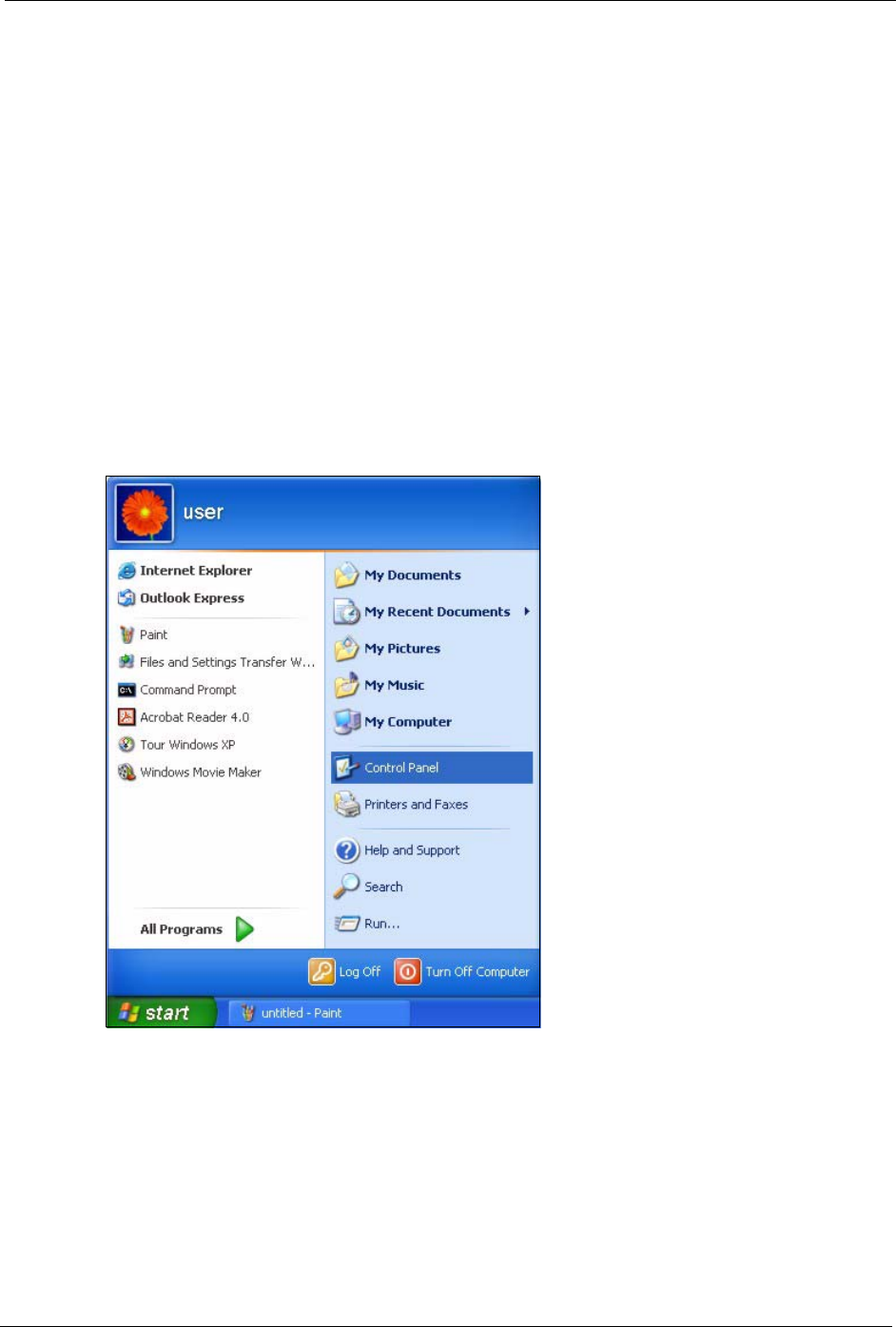
ZyXEL MAX-100 Series User’s Guide
55
APPENDIX C
Setting up Your Computer’s IP Address
All computers must have TCP/IP installed. Windows 2000 and Windows XP usually include
TCP/IP.
Configure the TCP/IP settings in order to communicate with your network.
Windows 2000/XP
1Click start (Start in Windows 2000), Control Panel.
Figure 26 Windows XP: Start Menu
2Click Network Connections (Network and Dial-up Connections in Windows 2000).
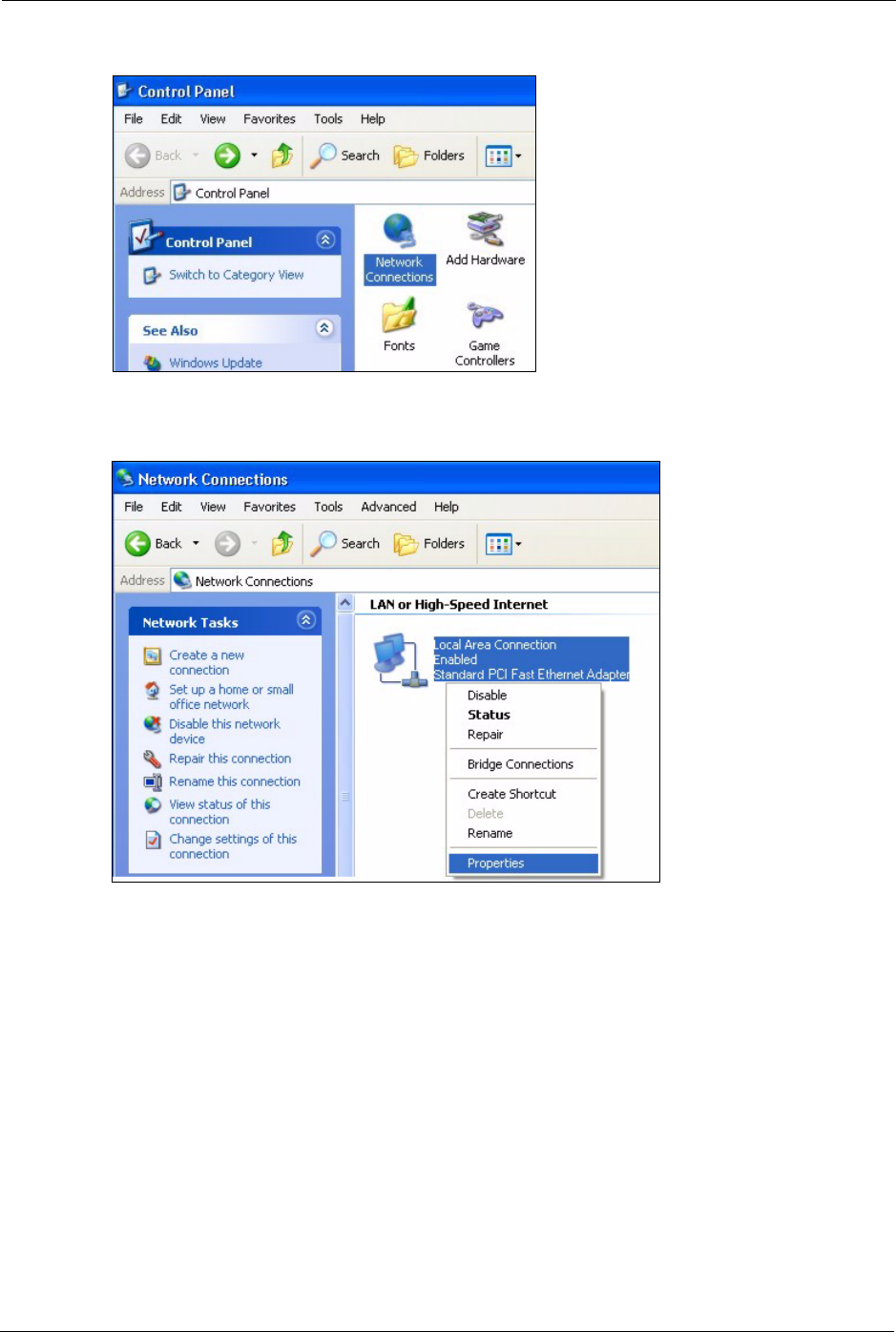
ZyXEL MAX-100 Series User’s Guide
56
Figure 27 Windows XP: Control Panel
3Right-click Local Area Connection and then click Properties.
Figure 28 Windows XP: Control Panel: Network Connections: Properties
4Select Internet Protocol (TCP/IP) (under the General tab in Win XP) and click
Properties.
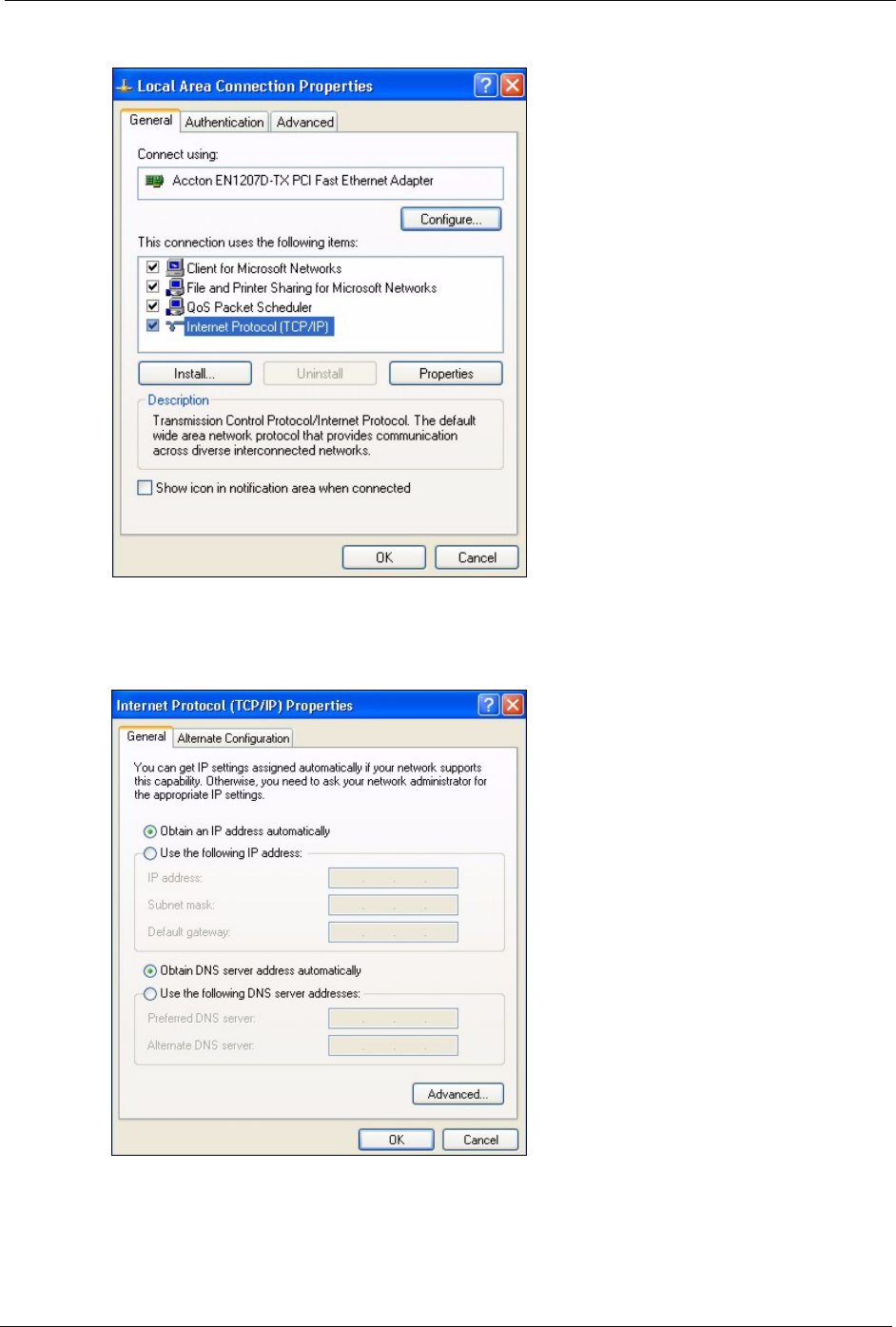
ZyXEL MAX-100 Series User’s Guide
57
Figure 29 Windows XP: Local Area Connection Properties
5The Internet Protocol TCP/IP Properties window (the General tab in Windows XP)
opens.
Figure 30 Windows XP: Internet Protocol TCP/IP Properties
• If you have a dynamic IP address click Obtain an IP address automatically.
• If you have a static IP address click Use the following IP Address and fill in the
IP address, Subnet mask, and Default gateway fields. Click Advanced.
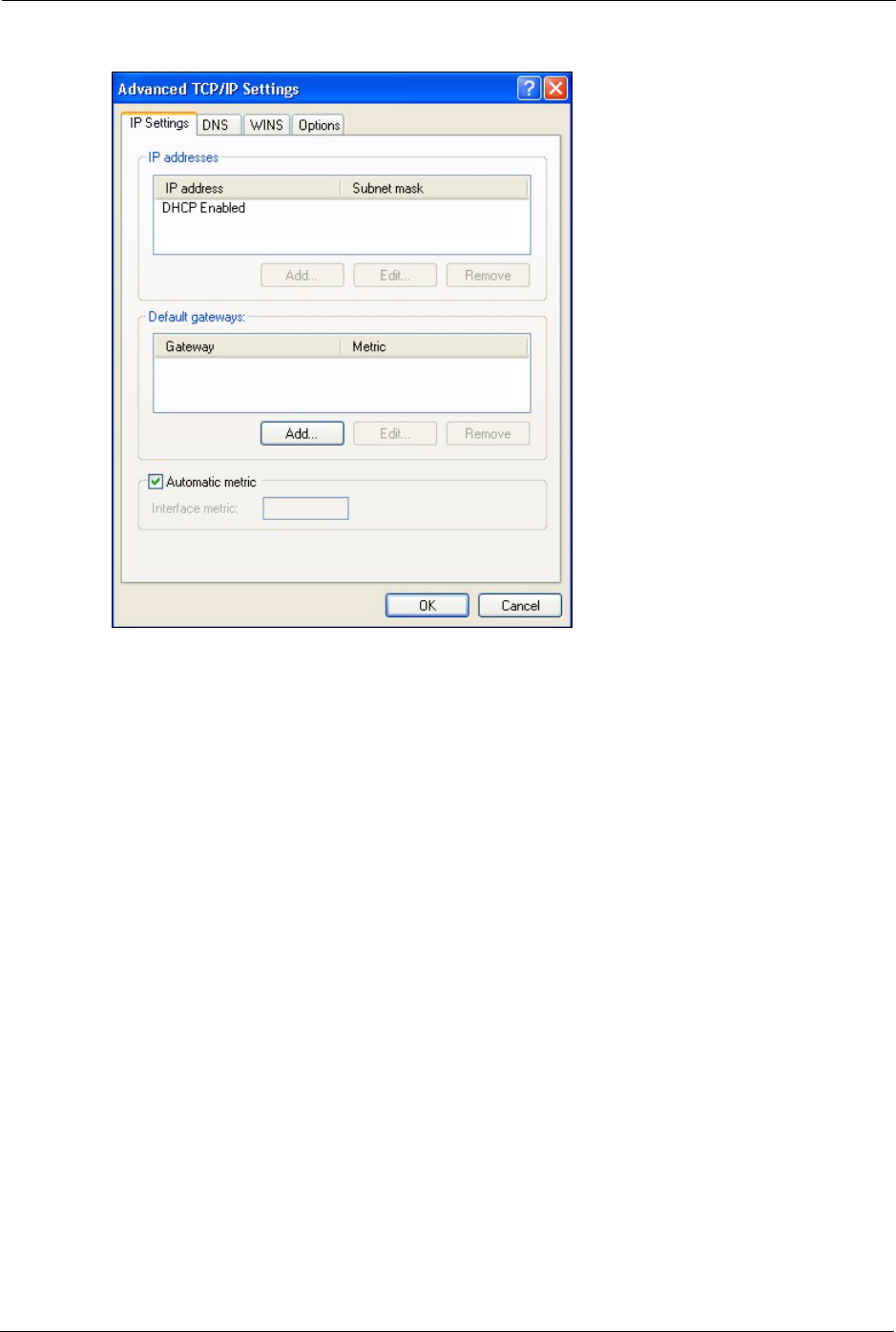
ZyXEL MAX-100 Series User’s Guide
58
Figure 31 Windows XP: Advanced TCP/IP Settings
6If you do not know your gateway's IP address, remove any previously installed gateways
in the IP Settings tab and click OK.
Do one or more of the following if you want to configure additional IP addresses:
•In the IP Settings tab, in IP addresses, click Add.
•In TCP/IP Address, type an IP address in IP address and a subnet mask in
Subnet mask, and then click Add.
• Repeat the above two steps for each IP address you want to add.
• Configure additional default gateways in the IP Settings tab by clicking Add in
Default gateways.
•In TCP/IP Gateway Address, type the IP address of the default gateway in
Gateway. To manually configure a default metric (the number of transmission
hops), clear the Automatic metric check box and type a metric in Metric.
• Click Add.
• Repeat the previous three steps for each default gateway you want to add.
• Click OK when finished.
7In the Internet Protocol TCP/IP Properties window (the General tab in Windows XP):
• Click Obtain DNS server address automatically if you do not know your DNS
server IP address(es).
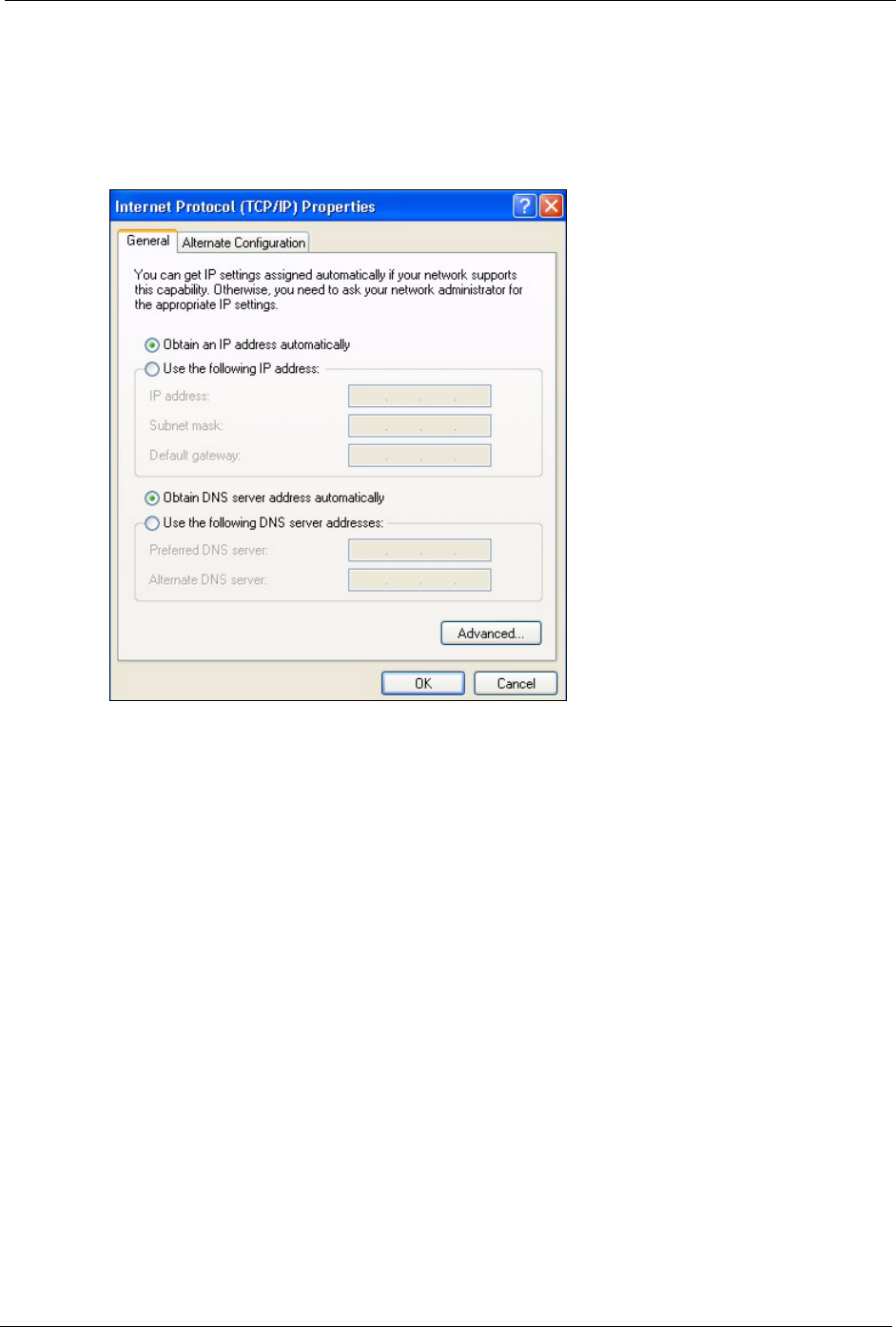
ZyXEL MAX-100 Series User’s Guide
59
• If you know your DNS server IP address(es), click Use the following DNS server
addresses, and type them in the Preferred DNS server and Alternate DNS
server fields. If you have previously configured DNS servers, click Advanced
and then the DNS tab to order them.
Figure 32 Windows XP: Internet Protocol (TCP/IP) Properties
8Click OK to close the Internet Protocol (TCP/IP) Properties window.
9Click Close (OK in Windows 2000) to close the Local Area Connection Properties
window.
10Close the Network Connections window (Network and Dial-up Connections in
Windows 2000).
11Restart your computer (if prompted).
Verifying Settings
1Click Start, All Programs, Accessories and then Command Prompt.
2In the Command Prompt window, type "ipconfig" and then press [ENTER]. You can
also open Network Connections, right-click a network connection, click Status and then
click the Support tab.

ZyXEL MAX-100 Series User’s Guide
60

ZyXEL MAX-100 Series User’s Guide
Index 61
Index
A
AAA 37
about 43
about your ZyXEL Device 19
account details 24
accounting server
see AAA
adapter 39
advanced encryption standard
see AES
AES 51
AK 52
anonymous identity 38
antenna 49
application example 23
authentication 37, 38, 51
inner 38, 53
types 53
authentication key
see AK
authentication server
see AAA
authorization 51
authorization request and reply 52
authorization server
see AAA
B
base station
see BS
BS 27
links 27
C
CA 54
CBC-MAC 52
CCMP 51, 52
CD 17
cell 27
certificate 51
verification 52
Certificate Authority
see CA
certifications 4
notices 5
viewing 5
chaining 52
chaining message authentication
see CCMP
CMAC
see MAC
configuration 27
statistics 29
connection 17, 20
status 21, 29
contact information 8
copyright 3
counter mode
see CCMP
coverage area 27
cryptography 51
customer support 8
D
data encryption 51, 52
data flow 52
data rate 49
statistics 29
decryption 51, 52
default values 24
Diameter 37
digital ID 51
dimensions 49
disclaimer 3
DL frequency 24, 25
download frequency
see DL frequency
driver 43, 49
duplex 49

ZyXEL MAX-100 Series User’s Guide
62 Index
E
EAP 37, 38
encoding 51
encryption 51, 52
environmental specifications 49
extensible authorization protocol
see EAP
F
FCC interference statement 4
firmware 29, 39
frequency 49
frequency band 25
scanning 25
frequency ranges 24, 25
G
graphics icons 18
H
hardware 17, 20
humidity 49
I
icons 18, 20
identity 37, 51
IEEE 802.16 19, 27, 51
IEEE 802.16e 27
inner authentication 53
installation 17, 20
interface 49
interference 48
Internet
access 23, 24, 37
Internet Service Provider
see ISP
interoperability 27
introduction 19
ISP 23
K
key 51
key request and reply 52
L
link quality
troubleshooting 48
M
MAC 52
MAN 27
manual site survey 24, 25
media access protocol 49
message authentication code
see MAC
message integrity 52
Metropolitan Area Network
see MAN
Microsoft Windows 21
microwave 27
mobile station
see MS
modulation 49
MS 27
N
network activity 37
network adapter 19
network services 37
notebook computer 19
O
operating humidity 49
operating temperature 49

ZyXEL MAX-100 Series User’s Guide
Index 63
output power 49
P
password 38
pattern-spotting 52
PCMCIA 17, 49
physical specifications 49
PKM 38
PKMv2 37, 51, 53
plain text encryption 52
power 49
privacy key management
see PKM
private key 51
product registration 7
product specifications
see specifications
profile 38
public certificate 52
public key 51
Q
Quick Start Guide 17, 20
R
radio specifications 49
RADIUS 37, 52
shared secret key 53
RADIUS messages 53
reception 48
registration
product 7
related documentation 17
S
safety warnings 6
secure communication 51
secure connection 37
security 49, 51
settings 29
security association 52
see SA
services 37
settings
frequency 24
Internet access 29
security 29
signal quality 25
signal strength 25
site survey 23, 24
specifications 49
physical and environmental 49
radio 49
SS 27
standards 49
storage humidity 49
storage temperature 49
subscriber station
see SS
support 17
syntax conventions 17
system tray 20
T
tabs 23, 24
tampering
TDD 49
TEK 52
temperature 49
terms 17
Time Division Duplex
see TDD
TLS 51
trademarks 3
transport encryption key
see TEK
transport layer security
see TLS
troubleshooting 47
Internet connection 47
link quality 48
ZyXEL utility 47
TTLS 38, 51, 53
tunneled TLS
see TTLS
tutorial 23

ZyXEL MAX-100 Series User’s Guide
64 Index
U
unauthorized device 51
upgrading 44
user authentication 51
user name 23, 24, 38
W
warranty 7
note 7
weather conditions 48
WiMAX 17, 19, 27
security 52
WiMAX Forum 27
wireless
configuration 27
wireless connection status 25
Wireless Interoperability for Microwave Access
see WiMAX
wireless Metropolitan Area Network
see MAN
wireless network 23
access 27
standard 27
wireless network adapter 19
wireless security 49, 51
Z
ZyXEL Device
about 19
ZyXEL utility 19, 20, 23, 27
access 21
icon 20
status 21
summary 28
troubleshooting 47
upgrading 44
version number 43